Racism in the United States
| Part of a series of articles on |
| Racial segregation |
|---|
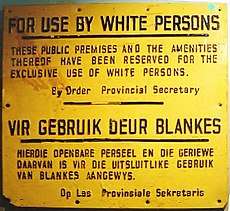 |
| Germany |
| South Africa |
| United States |
Racism in the United States has been widespread since the colonial era. Legally or socially sanctioned privileges and rights were given to white Americans but denied to all other races. European Americans (particularly affluent white Anglo-Saxon Protestants) were granted exclusive privileges in matters of education, immigration, voting rights, citizenship, land acquisition, and criminal procedure over a period of time extending from the 17th century to the 1960s. However, non-Protestant immigrants from Europe, particularly Irish people, Poles, and Italians, often suffered xenophobic exclusion and other forms of ethnicity-based discrimination in American society until the late 1800s and early 1900s. In addition, Middle Eastern American groups like Jews and Arabs have faced continuous discrimination in the United States, and as a result, some people belonging to these groups do not identify as white. East and South Asians have similarly faced racism in America.
Major racially and ethnically structured institutions include slavery, segregation, Native American reservations, Native American boarding schools, immigration and naturalization law, and internment camps.[1] Formal racial discrimination was largely banned in the mid-20th century and came to be perceived as socially and morally unacceptable. Racial politics remains a major phenomenon, and racism continues to be reflected in socioeconomic inequality.[2][3] Racial stratification continues to occur in employment, housing, education, lending, and government.
In the view of the United Nations and the U.S. Human Rights Network, "discrimination in the United States permeates all aspects of life and extends to all communities of color."[4] While the nature of the views held by average Americans have changed significantly over the past several decades, surveys by organizations such as ABC News have found that even in modern America, large sections of Americans admit to holding discriminatory viewpoints. For example, a 2007 article by ABC stated that about one in ten admitted to holding prejudices against Hispanic and Latino Americans and about one in four did so regarding Arab-Americans.[5] A 2018 YouGov/Economist poll found that 17% of Americans oppose interracial marriage, with 19% of "other" ethnic groups, 18% of blacks, 17% of whites, and 15% of Hispanics opposing.[6]
Some Americans saw the presidential candidacy of Barack Obama, and his election in 2008 as the first black president of the United States, as a sign that the nation had entered a new, post-racial era.[7][8] The populist radio host Lou Dobbs claimed in November 2009, "We are now in a 21st-century post-partisan, post-racial society."[9] Two months later, Chris Matthews, an MSNBC host, said of President Obama, "He is post-racial by all appearances. You know, I forgot he was black tonight for an hour."[10] The election of President Donald Trump has been viewed by some commentators as a racist backlash against the election of Barack Obama.[11]
During the 2010s, American society continues to experience high levels of racism and discrimination. One new phenomenon has been the rise of the "alt-right" movement: a white nationalist coalition that seeks the expulsion of sexual and racial minorities from the United States.[12] In August 2017, these groups attended a rally in Charlottesville, Virginia, intended to unify various white nationalist factions. During the rally, a white supremacist demonstrator drove his car into a group of counter-protesters, killing one person and injuring 19.[13][14] Since the mid-2010s, the Department of Homeland Security and the Federal Bureau of Investigation have considered white supremacist violence to be the leading threat of domestic terrorism in the United States.[15][16]
African Americans
Pre-Civil War
Atlantic slave trade
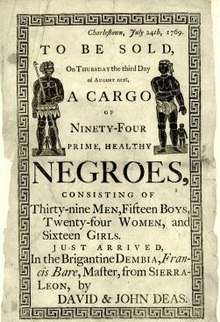
The Atlantic slave trade had an economic foundation. The dominant ideology among the European elite who structured national policy throughout the age of the Atlantic slave trade was mercantilism, the belief that national policy should be centered around amassing military power and economic wealth. Colonies were sources of mineral wealth and crops, to be used to the colonizing country's advantage.[17] Using Europeans for labor in the colonies proved unsustainably expensive, as well as harmful to the domestic labor supply of the colonizing countries. Instead, the colonies imported African slaves, who were "available in large numbers at prices that made plantation agriculture in the Americas profitable".[18]
It is also argued that along with the economic motives underlying slavery in the Americas, European world schemas played a large role in the enslavement of Africans. According to this view, the European in-group for humane behavior included the sub-continent, while African and American Indian cultures had a more localized definition of "an insider". While neither schema has inherent superiority, the technological advantage of Europeans became a resource to disseminate the conviction that underscored their schemas, that non-Europeans could be enslaved. With the capability to spread their schematic representation of the world, Europeans could impose a social contract, morally permitting three centuries of African slavery. While the disintegration of this social contract by the eighteenth century led to abolitionism, it is argued that the removal of barriers to "insider status" is a very slow process, uncompleted even today (2017).[19]
As a result of the above, the Atlantic slave trade prospered. According to estimates in the Trans-Atlantic Slave Trade Database, between 1626 and 1860 more than 470,000 slaves were forcibly transported from Africa to what is now the United States.[20][21] Prior to the Civil War, eight serving presidents owned slaves, a practice protected by the U.S. Constitution.[22] Providing wealth for the white elite, approximately one Southern family in four held slaves prior to the Civil War. According to the 1860 U.S. census, there were about 385,000 slave owners out of a white population in the slave states of approximately 7 million.[23][24]
Steps toward abolition of slavery

In the early part of the 19th century, a variety of organizations were established advocating the movement of black people from the United States to locations where they would enjoy greater freedom; some endorsed colonization, while others advocated emigration. During the 1820s and 1830s the American Colonization Society (A.C.S.) was the primary vehicle for proposals to return black Americans to greater freedom and equality in Africa,[25] and in 1821 the A.C.S. established the colony of Liberia, assisting thousands of former African-American slaves and free black people (with legislated limits) to move there from the United States. The colonization effort resulted from a mixture of motives with its founder Henry Clay stating, "unconquerable prejudice resulting from their color, they never could amalgamate with the free whites of this country. It was desirable, therefore, as it respected them, and the residue of the population of the country, to drain them off".[26]
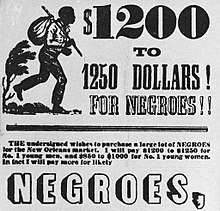
Although in 1820 the Atlantic slave trade was equated with piracy, punishable by death,[27] the practice of chattel slavery existed for the next half century. The domestic slave trade was a major economic activity in the U.S. which lasted until the 1860s.[28] Enslaved family members would be split up never to see each other again.[28] Between 1830 and 1840 nearly 250,000 slaves were taken across state lines.[28] In the 1850s more than 193,000 were transported, and historians estimate nearly one million in total took part in the forced migration.[28]
.jpg)
The historian Ira Berlin called this forced migration of slaves the "Second Middle Passage", because it reproduced many of the same horrors as the Middle Passage (the name given to the transportation of slaves from Africa to North America). These sales of slaves broke up many families, with Berlin writing that whether slaves were directly uprooted or lived in fear that they or their families would be involuntarily moved, "the massive deportation traumatized black people".[29] Individuals lost their connection to families and clans. Added to the earlier colonists combining slaves from different tribes, many ethnic Africans lost their knowledge of varying tribal origins in Africa. Most were descended from families who had been in the U.S. for many generations.[28]
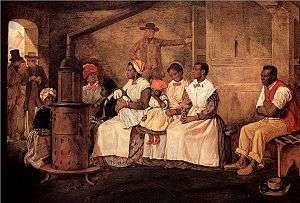
All slaves in only the areas of the Confederate States of America that were not under direct control of the United States government were declared free by the Emancipation Proclamation, which was issued on January 1, 1863, by President Abraham Lincoln.[30] While personally opposed to slavery, Lincoln believed that the Constitution did not give Congress the power to end slavery, stating in his first Inaugural Address that he "had no objection to [this] being made express and irrevocable" via the Corwin Amendment.[31] On social and political rights for blacks, Lincoln stated, "I am not, nor ever have been in favor of making voters or jurors of negroes, nor of qualifying them to hold office, nor to intermarry with white people, I as much as any man am in favor of the superior position assigned to the white race."[32] The Emancipation Proclamation did not apply to areas loyal to, or controlled by, the Union. Slavery was not actually abolished in the U.S. until the passage of the 13th Amendment which was declared ratified on December 6, 1865.[33]
About four million black slaves were freed in 1865. Ninety-five percent of blacks lived in the South, comprising one third of the population there as opposed to one percent of the population of the North. Consequently, fears of eventual emancipation were much greater in the South than in the North.[34] Based on 1860 census figures, 8% of males aged 13 to 43 died in the civil war, including 6% in the North and 18% in the South.[35]
Reconstruction Era to World War II
Reconstruction Era
After the Civil War, the 13th amendment in 1865, formally abolishing slavery, was ratified. Furthermore, Congress passed the Civil Rights Act of 1866, which broadened a range of civil rights to all persons born in the United States. Despite this, the emergence of "Black Codes", sanctioned acts of subjugation against blacks, continued to bar African-Americans from due civil rights. The Naturalization Act of 1790 limited U.S. citizenship to whites only, and in 1868 the effort toward civil rights was underscored with the 14th amendment which granted citizenship to blacks.[37] The Civil Rights Act of 1875 followed, which was eliminated in a decision that undermined federal power to thwart private racial discrimination.[38] Nonetheless, the last of the Reconstruction Era amendments, the 15th amendment promised voting rights to African-American men (previously only white men of property could vote), and these cumulative federal efforts, African-Americans began taking advantage of enfranchisement. African-Americans began voting, seeking office positions, utilizing public education. Yet by the end of Reconstruction in the mid 1870s, violent white supremacists came to power via paramilitary groups such as the Red Shirts and the White League and imposed Jim Crow laws that deprived African-Americans of voting rights and instituted systemic discriminatory policies through policies of unequal racial segregation.[39] Segregation, which began with slavery, continued with Jim Crow laws, with signs used to show blacks where they could legally walk, talk, drink, rest, or eat.[40] For those places that were racially mixed, non-whites had to wait until all white customers were dealt with.[40] Segregated facilities extended from white only schools to white only graveyards.[41]
Post-Reconstruction Era
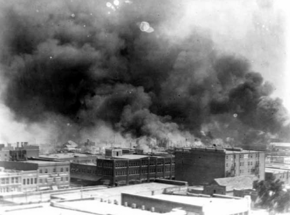
The new century saw a hardening of institutionalized racism and legal discrimination against citizens of African descent in the United States. Throughout this post Civil War period, racial stratification was informally and systemically enforced, in order to solidify the pre-existing social order. Although technically able to vote, poll taxes, pervasive acts of terror such as lynching in the United States (often perpetrated by groups such as the reborn Ku Klux Klan, founded in the Reconstruction South), and discriminatory laws such as grandfather clauses kept black Americans (and many Poor Whites) disenfranchised particularly in the South. Furthermore, discrimination extended to state legislation that "allocated vastly unequal financial support" for black and white schools. In addition to this, county officials sometimes redistributed resources earmarked for blacks to white schools, further undermining educational opportunities.[43] In response to de jure racism, protest and lobbyist groups emerged, most notably, the NAACP (National Association for the Advancement of Colored People) in 1909.[44]
This time period is sometimes referred to as the nadir of American race relations because racism, segregation, racial discrimination, and expressions of white supremacy all increased. So did anti-black violence, including race riots such as the Atlanta Race riot of 1906 and the Tulsa race riot of 1921. The Atlanta riot was characterized by the French newspaper Le Petit Journal as a "racial massacre of negroes".[45] The Charleston News and Courier wrote in response to the Atlanta riots: "Separation of the races is the only radical solution of the negro problem in this country. There is nothing new about it. It was the Almighty who established the bounds of the habitation of the races. The negroes were brought here by compulsion; they should be induced to leave here by persuasion."[46]
The Great Migration
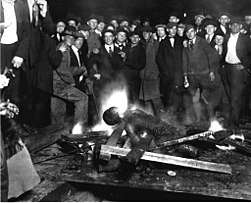
In addition, racism which had been viewed primarily as a problem in the Southern states, burst onto the national consciousness following the Great Migration, the relocation of millions of African Americans from their roots in the Southern states to the industrial centers of the North after World War I, particularly in cities such as Boston, Chicago, and New York City (Harlem). Within Chicago, for example, between 1910 and 1970, the percentage of African-Americans leapt from 2.0 percent to 32.7 percent.[48] The demographic patterns of black migrants and external economic conditions are largely studied stimulants regarding the Great Migration.[49] For example, migrating blacks (between 1910 and 1920) were more likely to be literate than blacks that remained in the South. Known economic push factors played a role in migration, such as the emergence of a split labor market and agricultural distress from the boll weevil destruction of the cotton economy.[50]
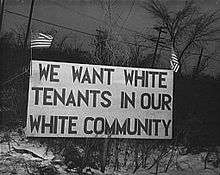
Southern migrants were often treated in accordance with pre-existing racial stratification. The rapid influx of blacks into the North disturbed the racial balance within cities, exacerbating hostility between both black and white Northerners. Stereotypic schemas of Southern blacks were used to attribute issues in urban areas, such as crime and disease, to the presence of African-Americans. Overall, African-Americans in Northern cities experienced systemic discrimination in a plethora of aspects of life. Within employment, economic opportunities for blacks were routed to the lowest-status and restrictive in potential mobility. Within the housing market, stronger discriminatory measures were used in correlation to the influx, resulting in a mix of "targeted violence, restrictive covenants, redlining and racial steering".[51]
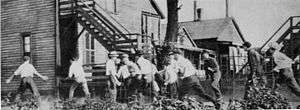
Throughout this period, racial tensions exploded, most violently in Chicago, and lynchings—mob-directed hangings, usually racially motivated—increased dramatically in the 1920s. Urban riots—whites attacking blacks—became a northern problem.[52] Many whites defended their space with violence, intimidation, or legal tactics toward African Americans, while many other whites migrated to more racially homogeneous suburban or exurban regions, a process known as white flight.[53] Racially restrictive housing covenants were ruled unenforceable under the Fourteenth Amendment in the 1948 landmark Supreme Court case Shelley v. Kraemer.[54]
Elected in 1912, President Woodrow Wilson ordered segregration throughout the federal government.[55] In World War I, blacks served in the United States Armed Forces in segregated units. Black soldiers were often poorly trained and equipped, and were often put on the frontlines in suicide missions. The U.S. military was still heavily segregated in World War II. The Air Force and the Marines had no blacks enlisted in their ranks. There were blacks in the Navy Seabees. In addition, no African-American would receive the Medal of Honor during the war, and black soldiers had to sometimes give up their seats in trains to the Nazi prisoners of war.[56]
World War II to Civil Rights Era
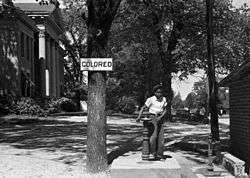
The Jim Crow Laws were state and local laws enacted in the Southern and border states of the United States and enforced between 1876 and 1965. They mandated "separate but equal" status for black Americans. In reality, this led to treatment and accommodations that were almost always inferior to those provided to white Americans. The most important laws required that public schools, public places and public transportation, like trains and buses, have separate facilities for whites and blacks. State-sponsored school segregation was declared unconstitutional by the Supreme Court of the United States in 1954 in Brown v. Board of Education. One of the first federal court cases to challenge segregation in schools was Mendez v. Westminster in 1946.
.jpg)
.jpg)
By the 1950s, the Civil Rights Movement was gaining momentum. Membership in the NAACP increased in states across the U.S. A 1955 lynching that sparked public outrage about injustice was that of Emmett Till, a 14-year-old boy from Chicago. Spending the summer with relatives in Money, Mississippi, Till was killed for allegedly having wolf-whistled at a white woman. Till had been badly beaten, one of his eyes was gouged out, and he was shot in the head before being thrown into the Tallahatchie River, his body weighed down with a 70-pound (32 kg) cotton gin fan tied around his neck with barbed wire. David Jackson writes that Mamie Till, Emmett's Mother, "brought him home to Chicago and insisted on an open casket. Tens of thousands filed past Till's remains, but it was the publication of the searing funeral image in Jet, with a stoic Mamie gazing at her murdered child's ravaged body, that forced the world to reckon with the brutality of American racism."[57] News photographs circulated around the country, and drew intense public reaction. The visceral response to his mother's decision to have an open-casket funeral mobilized the black community throughout the U.S.[58] Vann R. Newkirk wrote "the trial of his killers became a pageant illuminating the tyranny of white supremacy".[58] The state of Mississippi tried two defendants, but they were speedily acquitted by an all-white jury.[59]
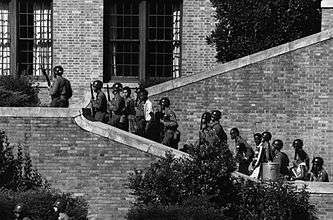
In response to heightening discrimination and violence, non-violent acts of protest began to occur. For example, in February 1960, in Greensboro, North Carolina, four young African-American college students entered a Woolworth store and sat down at the counter but were refused service. The men had learned about non-violent protest in college, and continued to sit peacefully as whites tormented them at the counter, pouring ketchup on their heads and burning them with cigarettes. After this, many sit-ins took place in order to non-violently protest against racism and inequality. Sit-ins continued throughout the South and spread to other areas. Eventually, after many sit-ins and other non-violent protests, including marches and boycotts, places began to agree to desegregate.[60]
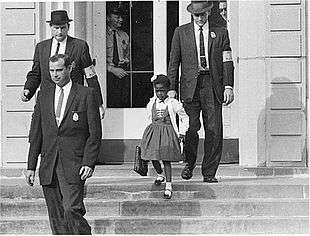
The 16th Street Baptist Church bombing marked a turning point during the Civil Rights Era. On Sunday, September 15, 1963 with a stack of dynamite hidden on an outside staircase, Ku Klux Klansmen destroyed one side of the Birmingham church. The bomb exploded in proximity to twenty-six children who were preparing for choir practice in the basement assembly room. The explosion killed four black girls, Carole Robertson (14), Cynthia Wesley (14), Denise McNair (11) and Addie Mae Collins (14).[61][62]
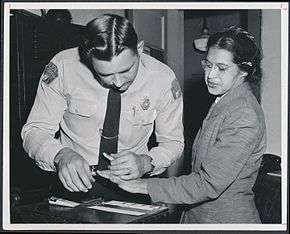
With the bombing occurring only a couple of weeks after Martin Luther King Jr.'s March on Washington for Jobs and Freedom, it became an integral aspect of transformed perceptions of conditions for blacks in America. It influenced the passage of the Civil Rights Act of 1964 (that banned discrimination in public accommodations, employment, and labor unions) and Voting Rights Act of 1965 which overruled remaining Jim Crow laws. Nonetheless, neither had been implemented by the end of the 1960s as civil rights leaders continued to strive for political and social freedom.
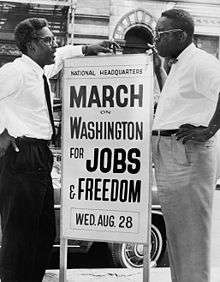
Many U.S. states banned interracial marriage. In 1967, Mildred Loving, a black woman, and Richard Loving, a white man, were sentenced to a year in prison in Virginia for marrying each other.[63] Their marriage violated the state's anti-miscegenation statute, the Racial Integrity Act of 1924, which prohibited marriage between people classified as white and people classified as "colored" (persons of non-white ancestry).[64] In the Loving v. Virginia case in 1967, the Supreme Court invalidated laws prohibiting interracial marriage in the U.S.[65]
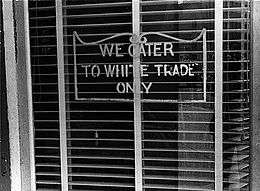
Segregation continued even after the demise of the Jim Crow laws. Data on house prices and attitudes toward integration suggest that in the mid-20th century, segregation was a product of collective actions taken by whites to exclude blacks from their neighborhoods.[66] Segregation also took the form of redlining, the practice of denying or increasing the cost of services, such as banking, insurance, access to jobs,[67] access to health care,[68] or even supermarkets[69] to residents in certain, often racially determined,[70] areas. Although in the U.S. informal discrimination and segregation have always existed, redlining began with the National Housing Act of 1934, which established the Federal Housing Administration (FHA). The practice was fought first through passage of the Fair Housing Act of 1968 (which prevents redlining when the criteria for redlining are based on race, religion, gender, familial status, disability, or ethnic origin), and later through the Community Reinvestment Act of 1977, which requires banks to apply the same lending criteria in all communities.[71] Although redlining is illegal some argue that it continues to exist in other forms.
Up until the 1940s, the full revenue potential of what was called "the Negro market" was largely ignored by white-owned manufacturers in the U.S. with advertising focused on whites.[72] Blacks were also denied commercial deals. On his decision to take part in exhibition races against racehorses in order to earn money, Olympic champion Jesse Owens stated, "People say that it was degrading for an Olympic champion to run against a horse, but what was I supposed to do? I had four gold medals, but you can't eat four gold medals."[73] On the lack of opportunities, Owens added, "There was no television, no big advertising, no endorsements then. Not for a black man, anyway."[74] In the reception to honor his Olympic success Owens was not permitted to enter through the main doors of the Waldorf Astoria New York and instead forced to travel up to the event in a freight elevator.[75] The first black Academy Award recipient Hattie McDaniel was not permitted to attend the premiere of Gone with the Wind with Georgia being racially segregated, and at the Oscars ceremony in Los Angeles she was required to sit at a segregated table at the far wall of the room; the hotel had a strict no-blacks policy, but allowed McDaniel in as a favor.[76]
1980s to present
_Church_Corrected.jpg)
While substantial gains were made in the succeeding decades through middle class advancement and public employment, black poverty and lack of education continued in the context of de-industrialization.[78][79] Despite gains made after the 16th Street Baptist Church bombing, some violence against black churches has also continued – 145 fires were set to churches around the South in the 1990s,[80] and a mass shooting in Charleston was perpetrated in 2015 at the historic Mother Emanuel Church.[81]
From 1981 to 1997, the United States Department of Agriculture discriminated against tens of thousands of black American farmers, denying loans that were provided to white farmers in similar circumstances. The discrimination was the subject of the Pigford v. Glickman lawsuit brought by members of the National Black Farmers Association, which resulted in two settlement agreements of $1.25 billion in 1999 and of $1.15 billion in 2009.[82]
During the 1980s and '90s a number of riots occurred that were related to longstanding racial tensions between police and minority communities. The 1980 Miami riots were catalyzed by the killing of an African-American motorist by four white Miami-Dade Police officers. They were subsequently acquitted on charges of manslaughter and evidence tampering. Similarly, the six-day 1992 Los Angeles riots erupted after the acquittal of four white LAPD officers who had been filmed beating Rodney King, an African-American motorist. Khalil Gibran Muhammad, the Director of the Harlem-based Schomburg Center for Research in Black Culture has identified more than 100 instances of mass racial violence in the United States since 1935 and has noted that almost every instance was precipitated by a police incident.[83]
Politically, the "winner-take-all" structure that applies to 48 out of 50 states[84] in the electoral college benefits white representation, as no state has voters of color as the majority of the electorate.[85] This has been described as structural bias and often leads voters of color to feel politically alienated, and therefore not to vote. The lack of representation in Congress has also led to lower voter turnout.[85] As of 2016, African Americans only made up 8.7% of Congress, and Latinos 7%.[86]
Many cite the United States presidential election, 2008 as a step forward in race relations: white Americans played a role in electing Barack Obama, the country's first black president.[87] In fact, Obama received a greater percentage of the white vote (43%),[88] than did the previous Democratic candidate, John Kerry (41%).[89] Racial divisions persisted throughout the election; wide margins of Black voters gave Obama an edge during the presidential primary, where 8 out of 10 African-Americans voted for him in the primaries, and an MSNBC poll found that race was a key factor in whether a candidate was perceived as being ready for office. In South Carolina, for instance,"Whites were far likelier to name Clinton than Obama as being most qualified to be commander in chief, likeliest to unite the country and most apt to capture the White House in November. Blacks named Obama over Clinton by even stronger margins—two- and three-to one—in all three areas."[90]
Sociologist Russ Long stated in 2013 that there is now a more subtle racism that associates a specific race with a specific characteristic.[91] In a 1993 study conducted by Katz and Braly, it was presented that "blacks and whites hold a variety of stereotypes towards each other, often negative".[92] The Katz and Braley study also found that African-Americans and whites view the traits that they identify each other with as threatening, interracial communication between the two is likely to be "hesitant, reserved, and concealing".[92] Interracial communication is guided by stereotypes; stereotypes are transferred into personality and character traits which then have an effect on communication. Multiple factors go into how stereotypes are established, such as age and the setting in which they are being applied.[92] For example, in a study done by the Entman-Rojecki Index of Race and Media in 2014, 89% of black women in movies are shown swearing and exhibiting offensive behavior while only 17% of white women are portrayed in this manner.[93]
In 2012, Trayvon Martin, a seventeen-year-old teenager was fatally shot by George Zimmerman in Sanford, Florida. Zimmerman, a neighborhood-watch volunteer, claimed that Martin was being suspicious and called the Sanford police to report.[94] Between ending his call with police and their arrival, Zimmerman fatally shot Martin outside of the townhouse he was staying at. National outrage occurred when Zimmerman was not charged in the shooting. The national coverage of the incident forced Sandford leaders to arrest Zimmerman. He was charged with second-degree murder, but was found not guilty. Public outcry occurred following his release and created an abundance of mistrust between minorities and the Sanford police.
In 2014, following the Shooting of Michael Brown, the Ferguson unrest took place. In the years following, mass media has followed shootings against other innocent black men and women, often with video evidence from body-worn cameras which places officers in real time. The U.S. Justice department launched the National Center for Building Community Trust and Justice in 2014.[95] This program is center on collected data concerning racial profiling to create a change in the criminal justice program concerning implicit and explicit racial bias towards African-Americans as well as other minorities.
It is reported that in 2015, there were 315,254 African-Americans deaths.[96] Only a few gain national media attention. For example, amongst 15 high-profile cases of an African-American being shot, only 1 officer faces prison time.[97]
Asian Americans
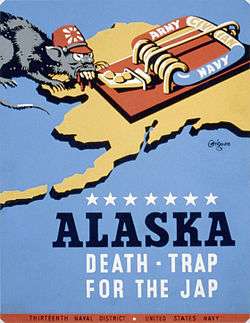
The Naturalization Act of 1790 made Asians ineligible for citizenship, with citizenship limited to whites only.[98]
Asian Americans, including those of East Asian, Southeast Asian, and South Asian descent, have experienced racism since the first major groups of Chinese immigrants arrived in America. First-generation immigrants, children of immigrants, and Asians adopted by non-Asian families have all been impacted.[99]
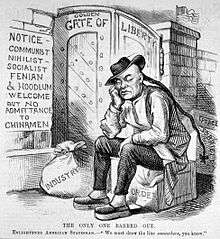
In the 19th century, America was undergoing rapid industrialization, leading to labor shortages in the mining and rail industries. Chinese immigrant labor was often used to fill this gap, most notably with the construction of the First Transcontinental Railroad, leading to large-scale Chinese immigration.[99] These Chinese immigrants were despised because they took the jobs of whites for cheaper pay, and the phrase Yellow Peril, which predicted the demise of Western Civilization as a result of Chinese immigrants, gained popularity.[100] This discrimination apexed with the 1882 Chinese Exclusion Act, which banned Chinese immigration to the United States. This was the first time that a law was passed to exclude a major group from the nation that was based on ethnicity and class.[99]
Local discriminatory laws were also enacted to stifle Chinese business and job opportunities; for example, in the 1886 Supreme Court case of Yick Wo v. Hopkins, a San Francisco city ordinance requiring permits for laundries (which were mostly Chinese-owned) was struck down, as it was clear the law solely targeted Chinese Americans. When the law was in effect, the city issued permits to virtually all non-Chinese permit applicants, while only granting one permit out of two hundred applications from Chinese laundry owners. When the Chinese laundries continued to operate, the city tried to fine the owners. In 1913, California, home to many Chinese immigrants, enacted an Alien Land Law, which significantly restricted land ownership by Asian immigrants, and extended it in 1920, ultimately banning virtually all land ownership by Asians.[101]
In 1907, Japanese immigrants, which were unaffected by the Exclusion Act, began to enter the United States, filling labor shortages that were once filled by Chinese workers. This influx also led to discrimination and was stymied when President Theodore Roosevelt restricted Japanese immigration. Later, Japanese immigration was closed when Japan entered into the Gentlemen's Agreement of 1907 to stop issuing passports to Japanese workers intending to move to the U.S.[102]
During World War II, the Republic of China was an ally of the United States, and the federal government praised the resistance of the Chinese against Japan in the Second Sino-Japanese War, attempting to reduce anti-Chinese sentiment. In 1943, the Magnuson Act was passed by Congress, repealing the Chinese Exclusion Act and reopening Chinese immigration. However, at the time, the United States was actively fighting the Empire of Japan, which was a member of the Axis powers. Anti-Japanese racism, which spiked after the attack on Pearl Harbor, was tacitly encouraged by the government, which used slurs such as "Jap" in propaganda posters and even interned Japanese Americans, citing possible security threats. Soldiers in the Pacific theater seem often dehumanized their enemy leading to American mutilation of Japanese war dead.[103] The racist nature of this dehumanization is apparent in the inconsistency of the treatment of corpses in the Pacific and the European theaters. Apparently some soldiers mailed home Japanese skulls as souvenirs, while none mailed home German or Italian skulls.[104] This prejudice continued for some time after the war, and Asian racism affected U.S. policy in the Korean and Vietnam Wars, even though Asians were on both sides of those wars as well as World War II. Some historians have alleged that a climate of racism, with unofficial rules like the "mere gook rule",[105][106] allowed for a pattern in which South Vietnamese civilians were treated as less than human and war crimes became common.[107]
Prior to 1965, Indian immigration to the U.S. was small and isolated, with fewer than fifty thousand Indian immigrants in the country. The Bellingham riots in Bellingham, Washington, on September 5, 1907, epitomized the low tolerance in the U.S. for Indians and Hindus. While anti-Asian racism was embedded in U.S. politics and culture in the early 20th century, Indians were also racialized for their anticolonialism, with U.S. officials, casting them as a Hindu menace, pushing for Western imperial expansion abroad.[108] In the 1923 case, United States v. Bhagat Singh Thind, the Supreme Court ruled that high caste Hindus were not "white persons" and were therefore racially ineligible for naturalized citizenship.[109] The Court argued that the racial difference between Indians and whites was so great that the "great body of our people" would reject assimilation with Indians.[109] It was after the Luce–Celler Act of 1946 that a quota of 100 Indians per year could immigrate to the U.S. and become citizens.[110]
The Immigration and Nationality Act of 1965 dramatically opened entry to the U.S. to immigrants other than traditional Northern European and Germanic groups, and as a result would significantly, and unintentionally, alter the demographic mix in the U.S.[111] On the U.S. immigration laws prior to 1965, sociologist Stephen Klineberg states the law "declared that Northern Europeans are a superior subspecies of the white race."[111] In 1990, Asian immigration was encouraged when nonimmigrant temporary working visas were given to help with the shortage of skilled labor within the United States.[99]
In modern times, Asians have been perceived as a "model minority". They are seen as more educated and successful, and are stereotyped as intelligent and hard-working, but socially inept.[112] Asians may experience expectations of natural intelligence and excellence from whites as well as other minorities.[101][113] This has led to discrimination in the workplace, as Asian Americans may face unreasonable expectations because of the "model minority" stereotype. In 2000, out of 1,218 adult Asian Americans, 92 percent of those who experienced personal discrimination believed that the unfair treatment was due to their ethnicity.[112]
Asian American stereotypes can also obstruct career paths; because Asians are seen as better skilled in engineering, computing, and mathematics, they are often encouraged to pursue technical careers. They are also discouraged from pursuing non-technical occupations or executive occupations requiring more social interaction, since Asians are expected to have poor social skills. In the 2000 study, forty percent of those surveyed who experienced discrimination believed that they had lost hiring or promotion opportunities. In 2007, the Equal Employment Opportunity Commission reported that Asians make up 10 percent of professional jobs, while 3.7 percent of them held executive, senior level, or manager positions.[112]
Other forms of discrimination include racial profiling and hate crimes. Research shows that discrimination has led to more use of informal mental health services by Asian Americans.[114] Asian Americans who feel discriminated against also tend to smoke more.[115]
European Americans
Various European American immigrant groups have been subject to discrimination either on the basis of their immigrant status (known as "Nativism") or on the basis of their ethnicities (country of origin).
In the 19th century, this was particularly true of anti-Irish prejudice, which was partly anti-Catholic sentiment, partly anti-Irish as an ethnicity. This was especially true for Irish Catholics who immigrated to the U.S. in the mid-19th century; the large number of Irish (both Catholic and Protestant) who settled in America in the 18th century had largely (but not entirely) escaped such discrimination and eventually blended into the American white population. During the 1830s in the U.S., riots for control of job sites broke out in rural areas among rival labour teams from different parts of Ireland, and between Irish and local American work teams competing for construction jobs.[116]
The Native American Party, commonly called the Know Nothing movement was a political party, whose membership was limited to Protestant men, that operated on a national basis during the mid-1850s and sought to limit the influence of Irish Catholics and other immigrants, thus reflecting nativism and anti-Catholic sentiment. There was widespread anti-Irish job discrimination in the United States and "No Irish need apply" signs were common.[117][118][119]
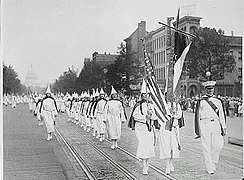
The second era Ku Klux Klan was a very large nationwide organization in the 1920s, consisting of between four to six million members (15% of the nation's eligible population) that especially opposed Catholics.[120] The revival of the Klan was spurred by the release of the 1915 film The Birth of a Nation.[121] The second and third incarnations of the Ku Klux Klan made frequent references to America's "Anglo-Saxon" blood.[122] Anti-Catholic sentiment, which appeared in North America with the first Pilgrim and Puritan settlers in New England in the early 17th century, remained evident in the United States up to the presidential campaign of John F. Kennedy, who went on to become the first Catholic (and first non-Protestant) U.S. president in 1961.[123]
The 20th century saw discrimination against immigrants from southern and eastern Europe (notably Italian Americans and Polish Americans), partly from anti-Catholic sentiment (as well as discrimination against Irish Americans), and partly from Nordicism, which considered all non-Germanic immigrants as racially inferior.
Biological laws tell us that certain divergent people will not mix or blend. The Nordics propagate themselves successfully. With other races, the outcome shows deterioration on both sides.
An advocate of the U.S. immigration laws that favored Northern Europeans, the Klansman Lothrop Stoddard wrote primarily on the alleged dangers posed by "colored" peoples to white civilization, with his most famous book The Rising Tide of Color Against White World-Supremacy in 1920. Nordicism led to the reduction in Southern European, along with Slavic Eastern European and Russian immigrants in the National Origins Formula of the Emergency Quota Act of 1921 and the Immigration Act of 1924, whose goal was to maintain the status quo distribution of ethnicity by limiting immigration of non-Northern Europeans. According to the U.S. Department of State the purpose of the act was "to preserve the ideal of American homogeneity".[125] The racial term Untermensch originates from the title of Stoddard's 1922 book The Revolt Against Civilization: The Menace of the Under-man.[126] It was later adopted by the Nazis (and its chief racial theorist Alfred Rosenberg) from that book's German version Der Kulturumsturz: Die Drohung des Untermenschen (1925).[127]
There was also discrimination against German Americans and Italian Americans due to Germany and Italy being enemy countries during World War I (Germany) and World War II (Germany and Italy). This resulted in a sharp decrease in German-American ethnic identity and a sharp decrease in the use of German in the United States following World War I, which had hitherto been significant, and to German American internment and Italian American internment during World War II; see also World War I anti-German sentiment.
Beginning in World War I, German Americans were sometimes accused of having political allegiances to Germany, and thus not to the United States.[128] The Justice Department attempted to prepare a list of all German aliens, counting approximately 480,000 of them, more than 4,000 of whom were imprisoned in 1917–18. The allegations included spying for Germany, or endorsing the German war effort.[129] Thousands were forced to buy war bonds to show their loyalty.[130] The Red Cross barred individuals with German last names from joining in fear of sabotage. One person was killed by a mob; in Collinsville, Illinois, German-born Robert Prager was dragged from jail as a suspected spy and lynched.[131] Questions of German American loyalty increased due to events like the German bombing of Black Tom island[132] and the U.S. entering World War I, many German Americans were arrested for refusing allegiance to the U.S.[133] War hysteria led to the removal of German names in public, names of things such as streets,[134] and businesses.[135] Schools also began to eliminate or discourage the teaching of the German language.[136] Years later during the Second World War, German Americans were once again the victims of war hysteria discrimination. Following its entry into the Second World War, the US Government interned at least 11,000 American citizens of German ancestry. The last to be released, a German-American, remained imprisoned until 1948 at Ellis Island,[137] three and a half years after the cessation of hostilities against Germany.
Specific racism against other European-American ethnicities significantly diminished as a political issue in the 1930s, being replaced by a bi-racialism of black/white, as described and predicted by Lothrop Stoddard, due to numerous causes. The National Origins Formula significantly reduced inflows of non-Nordic ethnicities; the Great Migration (of African-Americans out of the South) displaced anti-white immigrant racism with anti-black racism.[53]
Anti-Romanyism
The Roma population in America has blended more-or-less seamlessly into the rest of society. In the United States, the term "Gypsy" has come to be associated with a trade, profession, or lifestyle more than with the Romani ethnic/racial group. Some Americans, especially those self-employed in the fortune-telling and psychic reading business,[138] use the term "Gypsy" to describe themselves or their enterprise, despite having no ties to the Roma people. This can be chalked up to misperception and ignorance regarding the term rather than any bigotry or even anti-ziganism.[139]
Hispanic and Latino Americans
Americans of Latin American ancestry (often categorized as "Hispanic") come from a wide variety of racial and ethnic backgrounds. Latinos are not all distinguishable as a racial minority.
After the Mexican–American War (1846–1848), the United States annexed much of the current Southwestern region from Mexico. Mexicans residing in that territory found themselves subject to discrimination. It is estimated that at least 597 Mexicans were lynched between 1848 and 1928 (this is a conservative estimate due to lack of records in many reported lynchings). Mexicans were lynched at a rate of 27.4 per 100,000 of population between 1880 and 1930. This statistic is second only to that of the African American community during the same period, which suffered an average of 37.1 per 100,000 of population.[140] Between 1848 and 1879, Mexicans were lynched at an unprecedented rate of 473 per 100,000 of population.[141]
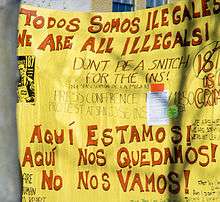
During The Great Depression, the U.S. government sponsored a Mexican Repatriation program which was intended to encourage Mexican immigrants to voluntarily return to Mexico, however, many were forcibly removed against their will. In total, up to one million persons of Mexican ancestry were deported, approximately 60 percent of those individuals were actually U.S. citizens.
The Zoot Suit riots were vivid incidents of racial violence against Latinos (e.g., Mexican-Americans) in Los Angeles in 1943. Naval servicemen stationed in a Latino neighborhood conflicted with youth in the dense neighborhood. Frequent confrontations between small groups and individuals had intensified into several days of non-stop rioting. Large mobs of servicemen would enter civilian quarters looking to attack Mexican American youths, some of whom were wearing zoot suits, a distinctive exaggerated fashion popular among that group.[142] The disturbances continued unchecked, and even assisted, by the local police for several days before base commanders declared downtown Los Angeles and Mexican American neighborhoods off-limits to servicemen.[143]
Many public institutions, businesses, and homeowners associations had official policies to exclude Mexican Americans. School children of Mexican American descent were subject to racial segregation in the public school system. In many counties, Mexican Americans were excluded from serving as jurors in court cases, especially in those that involved a Mexican American defendant. In many areas across the Southwest, they lived in separate residential areas, due to laws and real estate company policies.[144][145][146][147]
During the 1960s, Mexican American youth formed the Chicano Civil Rights Movement.
Jewish Americans
Antisemitism has also played a role in the United States. During the late 19th and early 20th centuries, hundreds of thousands of ethnic Jews were escaping the pogroms in Europe. They boarded boats from ports on the Baltic Sea and in Northern Germany, and largely arrived at Ellis Island, New York.[148]
It is suggested by Leo Rosten, in his book The Joys of Yiddish, that as soon as they left the boat, they were subject to racism from the port immigration authorities. The derogatory term kike was adopted when referring to Jews (because they often could not write so they may have signed their immigration papers with circles – or kikel in Yiddish).[149] Efforts were also made by the Asiatic Exclusion League to bar Jewish immigrants (along with other Middle Eastern ethnic groups, like Arabs, Assyrians, and Armenians) from naturalization, but they (along with Assyrians and Armenians) were nevertheless granted US citizenship, despite being classified as Asian.[150]
From the 1910s, the Southern Jewish communities were attacked by the Ku Klux Klan, who objected to Jewish immigration, and often used "The Jewish Banker" in their propaganda. In 1915, Leo Frank was lynched in Georgia after being convicted of rape and sentenced to death (his punishment was commuted to life imprisonment).[151] This event was a catalyst in the re-formation of the new Ku Klux Klan.[152]
The events in Nazi Germany also attracted attention from the United States. Jewish lobbying for intervention in Europe drew opposition from the isolationists, amongst whom was Father Charles Coughlin, a well known radio priest, who was known to be critical of Jews, believing that they were leading the United States into the war.[153] He preached in weekly, overtly anti-Semitic sermons and, from 1936, began publication of a newspaper, Social Justice, in which he printed anti-Semitic accusations such as The Protocols of the Elders of Zion.[154]
A number of Jewish organizations, Christian organizations, Muslim organizations, and academics consider the Nation of Islam to be anti-Semitic. Specifically, they claim that the Nation of Islam has engaged in revisionist and antisemitic interpretations of the Holocaust and exaggerates the role of Jews in the African slave trade.[155] The Anti-Defamation League (ADL) alleged that the NOI's Health Minister, Dr. Abdul Alim Muhammad, accused Jewish doctors of injecting blacks with the AIDS virus,[156] an allegation that Muhammad and The Washington Post have refuted.[157]
Although Jews are often perceived as white in the American mainstream, the relationship of Jews to whiteness remains complex, with some preferring not to identify as white.[158][159][160][161] Prominent activist and rabbi Michael Lerner argues, in a 1993 Village Voice article, that "in America, to be 'white' means to be the beneficiary of the past 500 years of European exploration and exploitation of the rest of the world" and that "Jews can only be deemed white if there is massive amnesia on the part of non-Jews about the monumental history of anti-Semitism".[161] African-American activist Cornel West, in an interview with the United States Holocaust Memorial Museum, has explained:
Even if some Jews do believe that they're white, I think that they've been duped. I think that antisemitism has proven itself to be a powerful force in nearly every post of Western civilization where Christianity has a presence. And so even as a Christian, I say continually to my Jewish brothers and sisters: don't believe the hype about your full scale assimilation and integration into the mainstream. It only takes an event or two for a certain kind of anti-Jewish, antisemitic sensibility to surface in places that you would be surprised. But I'm just thoroughly convinced that America is not the promised land for Jewish brothers and sisters. A lot of Jewish brothers say, "No, that's not true. We finally ..." Yeah—they said that in Alexandria. You said that in Weimar Germany.[162]
New antisemitism
In recent years some scholars have advanced the concept of New antisemitism, coming simultaneously from the Far Left, the far right, and radical Islam, which tends to focus on opposition to the creation of a Jewish homeland in the State of Israel, and argue that the language of Anti-Zionism and criticism of Israel are used to attack Jews more broadly. In this view, the proponents of the new concept believe that criticisms of Israel and Zionism are often disproportionate in degree and unique in kind, and attribute this to antisemitism.[163]
Yehuda Bauer, Professor of Holocaust Studies at the Hebrew University of Jerusalem, has argued that the concept of a "new antisemitism" is essentially false since it is in fact an alternative form of the old antisemitism of previous decades, which he believes remains latent at times but recurs whenever it is triggered. In his view, the current trigger is the Israeli situation; if a compromise making ground in the Arab-Israeli peace process were achieved, he believes that antisemitism would decline but not disappear.
Noted critics of Israel, such as Noam Chomsky and Norman Finkelstein, question the extent of new antisemitism in the United States. Chomsky has written in his work Necessary Illusions that the Anti-Defamation League casts any question of pro-Israeli policy as antisemitism, conflating and muddling issues as even Zionists receive the allegation.[164] Finkelstein has stated that supposed "new antisemitism" is a preposterous concept advanced by the ADL to combat critics of Israeli policy.[165]
Middle Eastern and South Asian Americans
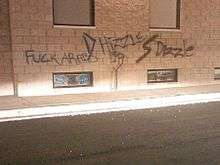
People of Middle Eastern and South Asian descent historically occupied an ambiguous racial status in the United States. Middle Eastern and South Asian immigrants were among those who sued in the late 19th and early 20th century to determine whether they were "white" immigrants as required by naturalization law. By 1923, courts had vindicated a "common-knowledge" standard, concluding that "scientific evidence", including the notion of a "Caucasian race" including Middle Easterners and many South Asians, was incoherent. Legal scholar John Tehranian argues that in reality this was a "performance-based" standard, relating to religious practices, education, intermarriage and a community's role in the United States.[167]
Arab Americans
Racism against Arab Americans[168] and racialized Islamophobia against Muslims has risen concomitantly with tensions between the American government and the Islamic world.[169] Following the September 11, 2001 attacks in the United States, discrimination and racialized violence has markedly increased against Arab Americans and many other religious and cultural groups.[170] Scholars, including Sunaina Maira and Evelyn Alsultany, argue that in the post-September 11 climate, Muslim Americans have been racialized within American society, although the markers of this racialization are cultural, political, and religious rather than phenotypic.[171][172]
Arab Americans in particular were most demonized which led to hatred towards Middle Easterners living in the United States and elsewhere in the Western world.[173][174] There have been attacks against Arabs not only on the basis of their religion (Islam), but also on the basis of their ethnicity; numerous Christian Arabs have been attacked based on their appearances.[175] In addition, other Middle Eastern peoples (Iranians, Assyrians, Armenians, Jews, Turks, Yezidis, Kurds, etc.) who are mistaken for Arabs because of perceived similarities in appearance have been collateral victims of anti-Arabism.
Non-Arab and non-Muslim Middle Eastern people, as well as South Asians of different ethnic/religious backgrounds (Hindus, Muslims and Sikhs) have been stereotyped as "Arabs". The case of Balbir Singh Sodhi, a Sikh who was murdered at a Phoenix gas station by a white supremacist for "looking like an Arab terrorist" (because of the turban that is a requirement of Sikhism), as well as that of Hindus being attacked for "being Muslims" have achieved prominence and criticism following the September 11 attacks.[176][177]
Those of Middle Eastern descent who are in the United States military sometimes face racism from fellow soldiers. Army Spc Zachari Klawonn endured numerous instances of racism during his enlistment at Fort Hood, Texas. During his basic training he was made to put cloth around his head and play the role of terrorist. His fellow soldiers had to take him down to the ground and draw guns on him. He was also called things such as "raghead", "sand monkey", and "Zachari bin Laden".[178][179]
According to a 2004 study, although official parameters encompass Arabs as part of the "white American" racial category, some Arab American adolescents do not identify as white.[180]
Iranian Americans

The November 1979 Iranian hostage crisis of the U.S. embassy in Tehran precipitated a wave of anti-Iranian sentiment in the United States, directed both against the new Islamic regime and Iranian nationals and immigrants. Even though such sentiments gradually declined after the release of the hostages at the start of 1981, they sometimes flare up. In response, some Iranian immigrants to the U.S. have distanced themselves from their nationality and instead identify primarily on the basis of their ethnic or religious affiliations.[181]
Since the 1980s and especially since the 1990s, it has been argued, Hollywood's depiction of Iranians has gradually shown signs of vilifying Iranians.[182] Hollywood network productions such as 24,[183] John Doe, On Wings of Eagles (1986),[184] Escape from Iran: The Canadian Caper (1981),[185] and JAG almost regularly host Persian speaking villains in their storyline.
Indian Americans
Indian Americans have sometimes been mistaken in the United States for Arab or Muslim, and thus many of the same prejudices faced by Arab Americans have been experienced by Indian Americans also, regardless of actual religious or ethnic background.
In the 1980s, a gang known as the Dotbusters specifically targeted Indian Americans in Jersey City, New Jersey with violence and harassment.[186] Studies of racial discrimination, as well as stereotyping and scapegoating of Indian Americans have been conducted in recent years.[187] In particular, racial discrimination against Indian Americans in the workplace has been correlated with Indophobia due to the rise in outsourcing/offshoring, whereby Indian Americans are blamed for US companies offshoring white-collar labor to India.[188][189] According to the offices of the Congressional Caucus on India, many Indian Americans are severely concerned of a backlash, though nothing serious has taken place yet.[189] Due to various socio-cultural reasons, implicit racial discrimination against Indian Americans largely go unreported by the Indian American community.[187]
Numerous cases of religious stereotyping of American Hindus (mainly of Indian origin) have also been documented.[190]
Since the September 11, 2001 attacks, there have been scattered incidents of Indian Americans becoming mistaken targets for hate crimes. In one example, a Sikh, Balbir Singh Sodhi, was murdered at a Phoenix gas station by a white supremacist. This happened after September 11, and the murderer claimed that his turban made him think that the victim was a Middle Eastern American. In another example, a pizza deliverer was mugged and beaten in Massachusetts for "being Muslim" though the victim pleaded with the assailants that he was in fact a Hindu.[191] In December 2012, an Indian American in New York City was pushed from behind onto the tracks at the 40th Street-Lowery Street station in Sunnyside and killed.[192] The police arrested a woman, Erika Menendez, who admitted to the act and justified it, stating that she shoved him onto the tracks because she believed he was "a Hindu or a Muslim" and she wanted to retaliate for the attacks of September 11, 2001.[193]
Native Americans

Native Americans, who have lived on the North American continent for at least 10,000 years,[194] had an enormously complex impact on American history and racial relations. During the colonial and independent periods, a long series of conflicts were waged, often with the objective of obtaining resources of Native Americans. Through wars, forced displacement (such as in the Trail of Tears), and the imposition of treaties, land was taken. The loss of land often resulted in hardships for Native Americans. In the early 18th century, the English had enslaved nearly 800 Choctaws.[195] After the creation of the United States, the idea of Indian removal gained momentum. However, some Native Americans chose or were allowed to remain and avoided removal whereafter they were subjected to official racism. The Choctaws in Mississippi described their situation in 1849, "we have had our habitations torn down and burned, our fences destroyed, cattle turned into our fields and we ourselves have been scourged, manacled, fettered and otherwise personally abused, until by such treatment some of our best men have died."[196] Joseph B. Cobb, who moved to Mississippi from Georgia, described Choctaws as having "no nobility or virtue at all," and in some respect he found blacks, especially native Africans, more interesting and admirable, the red man's superior in every way. The Choctaw and Chickasaw, the tribes he knew best, were beneath contempt, that is, even worse than black slaves.[197]
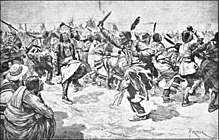
In the 1800s, conflicts were spurred by ideologies such as Manifest destiny, which held that the United States was destined to expand from coast to coast on the North American continent. In the years leading up to the Indian Removal Act of 1830 there were many armed conflicts between settlers and Native Americans.[198] A justification for the policy of conquest and subjugation of the indigenous people emanated from the stereotyped perceptions of all Native Americans as "merciless Indian savages" (as described in the United States Declaration of Independence).[199] Simon Moya-Smith, culture editor at Indian Country Today, states, "Any holiday that would refer to my people in such a repugnant, racist manner is certainly not worth celebrating. [July Fourth] is a day we celebrate our resiliency, our culture, our languages, our children and we mourn the millions – literally millions – of indigenous people who have died as a consequence of American imperialism."[200] In 1861, residents of Mankato, Minnesota, formed the Knights of the Forest, with a goal of 'eliminating all Indians from Minnesota.' An egregious attempt occurred with the California gold rush, the first two years of which saw the deaths of thousands of Native Americans. Under Mexican rule in California, Indians were subjected to de facto enslavement under a system of peonage by the white elite. While in 1850, California formally entered the Union as a free state, with respect to the issue of slavery, the practice of Indian indentured servitude was not outlawed by the California Legislature until 1863.[201] The 1864 deportation of the Navajos by the U.S. government occurred when 8,000 Navajos were forced to an internment camp in Bosque Redondo,[202] where, under armed guards, more than 3,500 Navajo and Mescalero Apache men, women, and children died from starvation and disease.[202]
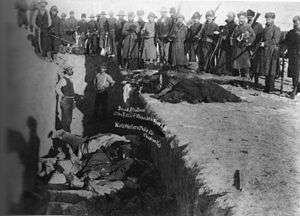
Native American nations on the plains in the west continued armed conflicts with the U.S. throughout the 19th century, through what were called generally Indian Wars.[204] Notable conflicts in this period include the Dakota War, Great Sioux War, Snake War and Colorado War. In the years leading up to the Wounded Knee massacre the U.S. government had continued to seize Lakota lands. A Ghost Dance ritual on the Northern Lakota reservation at Wounded Knee, South Dakota, led to the U.S. Army's attempt to subdue the Lakota. The dance was part of a religion founded by Wovoka that told of the return of the Messiah to relieve the suffering of Native Americans and promised that if they would live righteous lives and perform the Ghost Dance properly, the European American invaders would vanish, the bison would return, and the living and the dead would be reunited in an Edenic world.[205] On December 29, 1890, at Wounded Knee, gunfire erupted, and U.S. soldiers killed up to 300 Indians, mostly old men, women and children.[206]
During the period surrounding the 1890 Wounded Knee Massacre, author L. Frank Baum wrote two editorials about Native Americans. Five days after the killing of the Lakota Sioux holy man, Sitting Bull, Baum wrote, "The proud spirit of the original owners of these vast prairies inherited through centuries of fierce and bloody wars for their possession, lingered last in the bosom of Sitting Bull. With his fall the nobility of the Redskin is extinguished, and what few are left are a pack of whining curs who lick the hand that smites them. The Whites, by the law of conquest, by a justice of civilization, are masters of the American continent, and the best safety of the frontier settlements will be secured by the total annihilation of the few remaining Indians. Why not annihilation? Their glory has fled, their spirit broken, their manhood effaced; better that they die than live the miserable wretches that they are."[207] Following the December 29, 1890, massacre, Baum wrote, "The Pioneer has before declared that our only safety depends upon the total extermination [sic] of the Indians. Having wronged them for centuries we had better, in order to protect our civilization, follow it up by one more wrong and wipe these untamed and untamable creatures from the face of the earth. In this lies safety for our settlers and the soldiers who are under incompetent commands. Otherwise, we may expect future years to be as full of trouble with the redskins as those have been in the past."[207][208]
Military and civil resistance by Native Americans has been a constant feature of American history. So too have a variety of debates around issues of sovereignty, the upholding of treaty provisions, and the civil rights of Native Americans under U.S. law.
Reservation marginalization
Once their territories were incorporated into the United States, surviving Native Americans were denied equality before the law and often treated as wards of the state.[209]
Many Native Americans were moved to reservations—constituting 4% of U.S. territory. In a number of cases, treaties signed with Native Americans were violated. Tens of thousands of American Indians and Alaska Natives were forced to attend a residential school system which sought to reeducate them in white settler American values, culture and economy.[210][211]
The treatment of the Native Americans was admired by the Nazis.[212] Nazi expansion eastward was accompanied with invocation of America's colonial expansion westward under the banner of Manifest Destiny, with the accompanying wars on the Native Americans.[213] In 1928, Hitler praised Americans for having "gunned down the millions of Redskins to a few hundred thousand, and now kept the modest remnant under observation in a cage" in the course of founding their continental empire.[214] On Nazi Germany's expansion eastward, Hitler stated, "Our Mississippi [the line beyond which Thomas Jefferson wanted all Indians expelled] must be the Volga, and not the Niger."[213]
Further dispossession of various kinds continues into the present, although these current dispossessions, especially in terms of land, rarely make major news headlines in the country (e.g., the Lenape people's recent fiscal troubles and subsequent land grab by the State of New Jersey), and sometimes even fail to make it to headlines in the localities in which they occur. Through concessions for industries such as oil, mining and timber and through division of land from the Allotment Act forward, these concessions have raised problems of consent, exploitation of low royalty rates, environmental injustice, and gross mismanagement of funds held in trust, resulting in the loss of $10–40 billion.[215]
The Worldwatch Institute notes that 317 reservations are threatened by environmental hazards, while Western Shoshone land has been subjected to more than 1,000 nuclear explosions.[216]
Assimilation
.jpg)
The government appointed agents, like Benjamin Hawkins, to live among the Native Americans and to teach them, through example and instruction, how to live like whites.[217] America's first president, George Washington, formulated a policy to encourage the "civilizing" process.[218]
The Naturalization Act of 1790 limited citizenship to whites only. The Indian Citizenship Act of 1924 granted U.S. citizenship to all Native Americans. Prior to the passage of the act, nearly two-thirds of Native Americans were already U.S. citizens.[219] The earliest recorded date of Native Americans becoming U.S. citizens was in 1831 when the Mississippi Choctaw became citizens after the United States Legislature ratified the Treaty of Dancing Rabbit Creek. Under article XIV of that treaty, any Choctaw who elected not to move to Native American Territory could become an American citizen when he registered and if he stayed on designated lands for five years after treaty ratification.
While formal equality has been legally recognized, American Indians, Alaska Natives, Native Hawaiians, and Pacific Islanders remain among the most economically disadvantaged groups in the country, and according to National mental health studies, American Indians as a group tend to suffer from high levels of alcoholism, depression and suicide.[220]
Consequences
Developmental
Using The Schedule of Racist Events (SRE), an 18-item self-report inventory that assesses the frequency of racist discrimination, Hope Landrine and Elizabeth A. Klonoff found that racist discrimination is rampant in the lives of African Americans and is strongly related to psychiatric symptoms.[221] A study on racist events in the lives of African American women found that lifetime experiences of racism were positively related to lifetime history of both physical disease and frequency of recent common colds. These relationships were largely unaccounted for by other variables. Demographic variables such as income and education were not related to experiences of racism. The results suggest that racism can be detrimental to African American's well being.[222] The physiological stress caused by racism has been documented in studies by Claude Steele, Joshua Aronson, and Steven Spencer on what they term "stereotype threat."[223] Quite similarly, another example of the psychosocial consequences of discrimination have been observed in a study sampling Mexican-origin participants in Fresno, California. It was found that perceived discrimination is correlated with depressive symptoms, especially for those less acculturated in the United States, like Mexican immigrants and migrants.[224]
Along the vein of somatic responses to discrimination, Kennedy et al. found that both measures of collective disrespect were strongly correlated with black mortality (r = 0.53 to 0.56), as well as with white mortality (r = 0.48 to 0.54). These data suggest that racism, measured as an ecologic characteristic, is associated with higher mortality in both blacks and whites.[225] Some researchers also suggest that racial segregation may lead to disparities in health and mortality. Thomas LaVeist (1989; 1993) tested the hypothesis that segregation would aid in explaining race differences in infant mortality rates across cities. Analyzing 176 large and midsized cities, LaVeist found support for the hypothesis. Since LaVeist's studies, segregation has received increased attention as a determinant of racial disparities in mortality. Studies have shown that mortality rates for male and female African Americans are lower in areas with lower levels of residential segregation. Mortality for male and female whites was not associated in either direction with residential segregation.[226]
Researchers Sharon A. Jackson, Roger T. Anderson, Norman J. Johnson and Paul D. Sorlie found that, after adjustment for family income, mortality risk increased with increasing minority residential segregation among Blacks aged 25 to 44 years and non-Blacks aged 45 to 64 years. In most age/race/gender groups, the highest and lowest mortality risks occurred in the highest and lowest categories of residential segregation, respectively. These results suggest that minority residential segregation may influence mortality risk and underscore the traditional emphasis on the social underpinnings of disease and death.[227] Rates of heart disease among African Americans are associated with the segregation patterns in the neighborhoods where they live (Fang et al. 1998). Stephanie A. Bond Huie writes that neighborhoods affect health and mortality outcomes primarily in an indirect fashion through environmental factors such as smoking, diet, exercise, stress, and access to health insurance and medical providers.[228] Moreover, segregation strongly influences premature mortality in the US.[229]
As early as 1866, the Civil Rights Act provided a remedy for intentional race discrimination in employment by private employers and state and local public employers. The Civil Rights Act of 1871 applies to public employment or employment involving state action prohibiting deprivation of rights secured by the federal constitution or federal laws through action under color of law. Title VII is the principal federal statute with regard to employment discrimination prohibiting unlawful employment discrimination by public and private employers, labor organizations, training programs and employment agencies based on race or color, religion, gender, and national origin. Title VII also prohibits retaliation against any person for opposing any practice forbidden by statute, or for making a charge, testifying, assisting, or participating in a proceeding under the statute. The Civil Rights Act of 1991 expanded the damages available in Title VII cases and granted Title VII plaintiffs the right to a jury trial. Title VII also provides that race and color discrimination against every race and color is prohibited.
Societal
Schemas and stereotypes
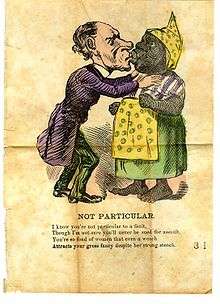
Media
Popular culture (songs, theater) for European American audiences in the 19th century created and perpetuated negative stereotypes of African Americans. One key symbol of racism against African Americans was the use of blackface. Directly related to this was the institution of minstrelsy. Other stereotypes of African Americans included the fat, dark-skinned "mammy" and the irrational, hypersexual male "buck".
In recent years increasing numbers of African-American activists have asserted that rap music videos commonly utilize scantily clothed African-American performers posing as thugs or pimps. The NAACP and the National Congress of Black Women also have called for the reform of images on videos and on television. Julian Bond said that in a segregated society, people get their impressions of other groups from what they see in videos and what they hear in music.[230][231][232][233]

In a similar vein, activists protested against the BET show, Hot Ghetto Mess, which satirizes the culture of working-class African-Americans. The protests resulted in the change of the television show name to We Got to Do Better.[230]
It is understood that representations of minorities in the media have the ability to reinforce or change stereotypes. For example, in one study, a collection of white subjects were primed by a comedy skit either showing a stereotypical or neutral portrayal of African-American characters. Participants were then required to read a vignette describing an incident of sexual violence, with the alleged offender either white or black, and assign a rating for perceived guilt. For those shown the stereotypical African-American character, there was a significantly higher guilt rating for black alleged offender in the subsequent vignette, in comparison to the other conditions.[234]
While schemas have an overt societal consequence, the strong development of them have lasting effect on recipients. Overall, it is found that strong in-group attitudes are correlated with academic and economic success. In a study analyzing the interaction of assimilation and racial-ethnic schemas for Hispanic youth found that strong schematic identities for Hispanic youth undermined academic achievement.[235]
Additional stereotypes attributed to minorities continue to influence societal interactions. For example, a 1993 Harvard Law Review article states that Asian-Americans are commonly viewed as submissive, as a combination of relative physical stature and Western comparisons of cultural attitudes. Furthermore, Asian-Americans are depicted as the model minority, unfair competitors, foreigners, and indistinguishable. These stereotypes can serve to dehumanize Asian-Americans and catalyze hostility and violence.[236]
Formal discrimination
Formal discrimination against minorities has been present throughout American history. Leland T. Saito, Associate Professor of Sociology and American Studies & Ethnicity at the University of Southern California, writes, "Political rights have been circumscribed by race, class and gender since the founding of the United States, when the right to vote was restricted to white men of property. Throughout the history of the United States race has been used by whites – a category that has also shifted through time – for legitimizing and creating difference and social, economic and political exclusion."[237]
Within education, a survey of black students in sixteen majority white universities found that four of five African-Americans reported some form of racial discrimination. For example, in February 1988, the University of Michigan enforced a new anti discrimination code following the distribution of fliers saying blacks "don't belong in classrooms, they belong hanging from trees". Other forms of reported discrimination were refusal to sit next to black in lecture, ignored input in class settings, and informal segregation. While the penalties are imposed, the psychological consequences of formal discrimination can still manifest. Black students, for example, reported feelings of heightened isolation and suspicion. Furthermore, studies have shown that academic performance is stunted for black students with these feelings as a result of their campus race interactions.[238]
Minority-minority racism
Minority racism is sometimes considered controversial because of theories of power in society. Some theories of racism insist that racism can only exist in the context of social power to impose it upon others.[239] Yet discrimination and racism between racially marginalized groups has been noted. For example, there has been ongoing violence between African American and Mexican American gangs, particularly in Southern California.[240][241][242][243] There have been reports of racially motivated attacks against Mexican Americans who have moved into neighborhoods occupied mostly by African Americans, and vice versa.[244][245] According to gang experts and law enforcement agents, a longstanding race war between the Mexican Mafia and the Black Guerilla Family, a rival African American prison gang, has generated such intense racial hatred among Mexican Mafia leaders, or shot callers, that they have issued a "green light" on all blacks. This amounts to a standing authorization for Latino gang members to prove their mettle by terrorizing or even murdering any blacks sighted in a neighborhood claimed by a gang loyal to the Mexican Mafia.[246] There have been several significant riots in California prisons where Mexican American inmates and African Americans have targeted each other particularly, based on racial reasons.[247][248]
There has also been noted conflict between recent immigrant groups and their established ethnic counterparts within the United States. Rapid growth in African and Caribbean immigrants has come into conflict with American blacks. Interaction and cooperation between black immigrants and American blacks are, ironically, debatable. One can argue that racial discrimination and cooperation is not ordinarily based on color of skin but more on shared common, cultural experiences, and beliefs.[249][250] Furthermore, conflict between Chinese immigrants and Japanese Americans are known to have occurred in the San Gabriel Valley of the Los Angeles area in the 1980s.
Interpersonal discrimination
In a manner that defines interpersonal discrimination in the United States, Darryl Brown of the Virginia Law Review states that while "our society has established a consensus against blatant, intentional racism and in decades since Brown v Board of Education has developed a sizeable set of legal remedies to address it", our legal system "ignores the possibility that 'race' is structural or interstitial, that it can be the root of injury even when not traceable to a specific intention or action"[251]
Interpersonal discrimination is defined by its subtlety. Unlike formal discrimination, interpersonal discrimination is often not an overt or deliberate act of racism. For example, in an incident regarding a racial remark from a professor at Virginia Law, a rift was created by conflicting definitions of racism. For the students that defended the professor's innocence, "racism was defined as an act of intentional maliciousness". Yet for African Americans, racism was broadened to a detrimental influence on "the substantive dynamics of the classroom". As an effect, it is argued that the "daily repetition of subtle racism and subordination in the classroom and on campus can ultimately be, for African Americans, more productive of stress, anxiety and alienation than even blatant racists acts". Moreover, the attention to these acts of discrimination diverts energy from academics, becoming a distraction that white students do not generally face.[251]
Institutional
Institutional racism is the theory that aspects of the structure, pervasive attitudes, and established institutions of society disadvantage some racial groups, although not by an overtly discriminatory mechanism.[252] There are several factors that play into institutional racism, including but not limited to: accumulated wealth/benefits from racial groups that have benefited from past discrimination, educational and occupational disadvantages faced by non-native English speakers in the United States, ingrained stereotypical images that still remain in the society (e.g. black men are likely to be criminals).[253]
In his article, Peter Kaufman describes three instances in which institutional racism has contributed to current views of race.[254] These are:
- The mis- and Missing Education of Race, in which he describes problems the educational system has in discussing "slavery, race, racism, and topics such as white privilege". He goes on to say that schools are still segregated based on class and race, which also contributes to race relations[254]
- Residential Racial Segregation. According to Kaufman, the reason that schools are still segregated is due to towns and cities being largely segregated still.
- Media Monsters. This describes the role in which the media has in the portrayal of race. Mass media tends to play on "depictions of racialized stereotypes in the mass media [which are] ubiquitous, and such caricaturized images shape our perceptions of various racial groups". An example of this is the stereotyping of Blacks as criminals.[254][255]
Immigration
Access to United States citizenship was restricted by race, beginning with the Naturalization Act of 1790 which excluded "non-whites" from citizenship.[37] Institutionalized prejudice existed against white followers of Roman Catholicism who immigrated from countries such as Ireland, Germany, Italy and France.[256] Other efforts include the 1882 Chinese Exclusion Act and the 1924 National Origins Act.[257][258] The Immigration Act of 1924 was aimed at further restricting the Southern and Eastern Europeans who had begun to enter the country in large numbers beginning in the 1890s. By limiting immigration of non-Northern Europeans, according to the U.S. Department of State Office of the Historian the purpose of the 1924 act was "to preserve the ideal of American homogeneity".[259]
German praise for America's institutional racism, previously found in Hitler's Mein Kampf, was continuous throughout the early 1930s, and Nazi lawyers were advocates of the use of American models.[260] U.S. citizenship laws and anti-miscegenation laws directly inspired the two principal Nuremberg Laws—the Citizenship Law and the Blood Law.[260]
In conjunction with immigration reform in the late 1980s (seen with the Immigration Reform and Control Act of 1986), there have been noted IRCA-related discriminatory behavior toward Hispanics within employment. As the measure made it unlawful to hire without authorization to work in the United States, avoidant treatment toward "foreign-appearing workers" increased to bypass the required record-keeping or risk of sanctions.[261]
Wealth
Large racial differentials in wealth remain in the United States: between whites and African Americans, the gap is a factor of twenty.[262] An analyst of the phenomenon, Thomas Shapiro, professor of law and social policy at Brandeis University argues, "The wealth gap is not just a story of merit and achievement, it's also a story of the historical legacy of race in the United States."[263] Differentials applied to the Social Security Act (which excluded agricultural workers, a sector that then included most black workers), rewards to military officers, and the educational benefits offered returning soldiers after World War II. Pre-existing disparities in wealth are exacerbated by tax policies that reward investment over waged income, subsidize mortgages, and subsidize private sector developers.[264]
Health care
There are major racial differences in access to health care and in the quality of health care provided. A study published in the American Journal of Public Health estimated that: "over 886,000 deaths could have been prevented from 1991 to 2000 if African Americans had received the same care as whites". The key differences they cited were lack of insurance, inadequate insurance, poor service, and reluctance to seek care.[265] A history of government-sponsored experimentation, such as the notorious Tuskegee Syphilis Study has left a legacy of African American distrust of the medical system.[266]
Inequalities in health care may also reflect a systemic bias in the way medical procedures and treatments are prescribed for different ethnic groups. A University of Edinburgh Professor of Public Health, Raj Bhopal, writes that the history of racism in science and medicine shows that people and institutions behave according to the ethos of their times and warns of dangers to avoid in the future.[267] A Harvard Professor of Social Epidemiology contended that much modern research supported the assumptions needed to justify racism. Racism she writes underlies unexplained inequities in health care, including treatment for heart disease,[268] renal failure,[269] bladder cancer,[270] and pneumonia.[271] Bhopal writes that these inequalities have been documented in various studies and that there are consistent findings that black Americans receive less health care than white Americans—particularly where this involves expensive new technology.[272] The University of Michigan Health study found in 2010 that black patients in pain clinics received 50% of the amount of drugs that other patients who were white received.[273] Black pain in medicine links to the racial disparities between pain management and racial bias on behalf of the health professional. In 2011, Vermont organizers took a proactive stand against racism in their communities to defeat the biopolitical struggles faced on a daily basis. The first and only universal health care law was passed in the state.[274]
Politics
It is argued that racial coding of concepts like crime and welfare has been used to strategically influence public political views. Racial coding is implicit; it incorporates racially primed language or imagery to allude to racial attitudes and thinking. For example, in the context of domestic policy, it is argued that Ronald Reagan implied linkages between concepts like "special interests" and "big government" with ill-perceived minority groups in the 1980s, using the conditioned negativity toward the minority groups to discredit certain policies and programs during campaigns. In a study analyzing how political ads prime attitudes, Valentino compares the voting responses of participants after being exposed to narration of a George W. Bush advertisement paired with three different types of visuals with different embedded racial cues to create three conditions: neutral, race comparison, and undeserving blacks. For example, as the narrator states "Democrats want to spend your tax dollars on wasteful government programs", the video shows an image of a black woman and child in an office setting. Valentino found that the undeserving blacks condition produced the largest primed effect in racialized policies, like opposition to affirmative action and welfare spending.[275]
Ian Haney-López, Professor of Law at the University of California, Berkeley, refers to this phenomenon as dog-whistle politics, which has pushed, he argues, middle class white Americans to vote against their economic self-interest in order to punish "undeserving minorities" who, they believe, are receiving too much public assistance at their expense. According to López, conservative middle-class whites, convinced that minorities are the enemy by powerful economic interests, supported politicians who promised to curb illegal immigration and crack down on crime, but inadvertently they also voted for policies that favor the extremely rich, such as slashing taxes for top income brackets, giving corporations more regulatory control over industry and financial markets, busting unions, cutting pensions for future public employees, reducing funding for public schools, and retrenching the social welfare state. He argues that these same voters cannot link rising inequality which has impacted their lives to the policy agendas they support, which resulted in a massive transfer of wealth to the top 1% of the population since the 1980s.[276]
Justice system
Racial disparities have been noted in all levels of the U.S. justice system. According to 2009 congressional testimony from Marc Mauer; while African Americans comprise 13% of the US population and 14% of monthly drug users they are 37% of the people arrested for drug offenses; as well as 56% of the people in state prisons for drug offenses. The U.S. Sentencing Commission reported in March 2010 that in the federal system black offenders receive sentences that are 10% longer than white offenders for the same crimes. A July 2009 report by the Sentencing Project found that two-thirds of the people in the U.S. with life sentences are non-white.[277] According to a new report, African-Americans are three times as likely to be killed by police as white Americans.[278]
Contemporary issues
Hate crimes
In the United States, most crimes that target victims on the basis of their race or ethnicity are considered hate crimes. (For federal law purposes, crimes targeting Hispanics because of their identity are considered hate crimes based on ethnicity.) Leading forms of bias cited in the FBI's Uniform Crime Reporting (UCR) Program, based on law enforcement agency filings are: anti-black, anti-Jewish, anti-white, anti-homosexual, and anti-Hispanic bias in that order in both 2004 and 2005.[279] According to the Bureau of Justice Statistics, whites, blacks, and Hispanics had similar rates of violent hate crime victimization between 2007 and 2011.[280][281] However, from 2011 to 2012, violent hate crimes against Hispanic people increased by 300%.[282] When considering all hate crimes, and not just violent ones, African Americans are far more likely to be victims than other racial groups.[283][284]
The New Century Foundation, a white nationalist organization founded by Jared Taylor, argues that blacks are more likely than whites to commit hate crimes, and that FBI figures inflate the number of hate crimes committed by whites by counting Hispanics as "white".[285] Other analysts are sharply critical of the NCF's findings, referring to the mainstream criminological view that "Racial and ethnic data must be treated with caution. Existing research on crime has generally shown that racial or ethnic identity is not predictive of criminal behavior with data which has been controlled for social and economic factors."[286] NCF's methodology and statistics are further sharply criticized as flawed and deceptive by anti-racist activists Tim Wise and the Southern Poverty Law Center.[287][288]
The first post-Jim Crow era hate crime to make sensational media attention was the murder of Vincent Chin, an Asian American of Chinese descent in 1982. He was attacked by two white assailants who were recently laid off from a Detroit area auto factory job and blamed the Japanese for their individual unemployment. Chin was not of Japanese descent, but the assailants testified at the criminal court case that he "looked like a Jap", an ethnic slur used to describe Japanese and other Asians, and that they were angry enough to beat him to death.
Hateful views
Continuing antisemitism in the United States has remained an issue as the 2011 Survey of American Attitudes Toward Jews in America, released by the Anti-Defamation League (ADL), has found that the recent world economic recession increased some antisemitic viewpoints among Americans. Most people express pro-Jewish sentiments, with 64% of those surveyed agreeing that Jews have contributed much to U.S. social culture. Yet the polling found that 19% of Americans answered "probably true" to the antisemitic canard that "Jews have too much control/influence on Wall Street" while 15% concurred with the related statement that Jews seem "more willing to use shady practices" in business. Reflecting on the lingering antisemitism of about one in five Americans, Abraham H. Foxman, ADL national director, has argued, "It is disturbing that with all of the strides we have made in becoming a more tolerant society, anti-Semitic beliefs continue to hold a vice-grip on a small but not insubstantial segment of the American public."[289]
An ABC News report in 2007 recounted that past ABC polls across several years have tended to find that "six percent have self-reported prejudice against Jews, 27 percent against Muslims, 25 percent against Arabs," and "one in 10 concedes harboring at least some such feelings" against Hispanic Americans. The report also remarked that a full 34% of Americans reported "some racist feelings" in general as a self-description.[5] An Associated Press and Yahoo News survey of 2,227 adult Americans in 2008 found that 10% of white respondents stated that "a lot" of discrimination against African-Americans exists while 45% answered "some" compared to 57% of black respondents answering that "a lot" exists. In the same poll, more whites applied positive attributes to black Americans than negative ones, with blacks describing whites even more highly, but a significant minority of whites still called their fellow Americans "irresponsible", "lazy", or other such things.[290]
In 2008, Stanford University political scientist Paul Sniderman remarked that, in the modern U.S., racism and prejudices are "a deep challenge, and it's one that Americans in general, and for that matter, political scientists, just haven't been ready to acknowledge fully."[290]
In 2017, citizens gathered in the college community of Charlottesville, Virginia to attend the Unite the Right rally. One woman was killed and dozens of other people were injured when a white supremacist drove his car into a group of counter-protesters. Vice President Mike Pence condemned the violence stating, "We have no tolerance for hate and violence from white supremacists, neo-Nazis or the KKK. These dangerous fringe groups have no place in American public life and in the American debate and we condemn them in the strongest possible terms."[291]
Alleviation
There is a wide plethora of societal and political suggestions to alleviate the effects of continued discrimination in the United States. For example, within universities, it has been suggested that a type of committee could respond to non-sanctionable behavior.[251]
It is also argued that there is a need for "white students and faculty to reformulate white-awareness toward a more secure identity that is not threatened by black cultural institutions and that can recognize the racial non-neutrality of the institutions whites dominate" (Brown, 334). Paired with this effort, Brown encourages the increase in minority faculty members, so the embedded white normative experience begins to fragment.[251]
Within media, it is found that racial cues prime racial stereotypic thought. Thus, it is argued that "stereotype inconsistent cues might lead to more intentioned thought, thereby suppressing racial priming effects."[275] Social psychologists, such as Jennifer Eberhardt, have done work that indicates such priming effects subconsciously help determine attitudes and behavior toward individuals regardless of intentions. These results have been incorporated into training, for example, in some police departments.[292]
It has been argued that more evidence-based guidance from psychologists and sociologists is needed to learn what is effective in alleviating racism.[293] Such evidence-based approaches can reveal, for example, the many psychological biases to which humans are subject, such as ingroup bias and the fundamental attribution error, which can underlie racist attitudes.[294]
Psychologist Stuart Vyse has argued that argument, ideas, and facts will not mend divisions but that there is evidence, such as that provided by the Robbers Cave Experiment, that seeking shared goals can help alleviate racism.[295]
See also
| Wikiquote has quotations related to: Racism in the United States |
- Affirmative action in the United States
- Anti-Americanism
- Category:Anti-black racism in the United States
- Anti-French sentiment in the United States
- Anti-Italianism in the United States
- Antisemitism in the United States
- Black Lives Matter
- Constitutional colorblindness
- Environmental racism in the United States
- Eugenics in the United States
- Illegal immigration to the United States
- List of race riots in the United States
- Native American mascot controversy
- Nativism in the United States
- Post-racial America
- Racial equality proposal
- Racial profiling in the United States
- Racism by country
- Racism in early American film
- Racism in United States politics
- Reverse discrimination
- Scientific racism in the United States
- U.S. Commission on Civil Rights
- White privilege in the United States
References
- ↑ Internment camps are particularly associated with World War II, but also occurred during World War I. Most significant was the Japanese American internment of 120,000 Japanese Americans during World War II. There was also internment of almost 11,000 German Americans in German American internment during World War II, and some Italian American internment.
- ↑ In his 2009 visit to the US, the [UN] Special Rapporteur on Racism noted that "Socio-economic indicators show that poverty and race and ethnicity continue to overlap in the United States. This reality is a direct legacy of the past, in particular slavery, segregation, the forcible resettlement of Native Americans, which was confronted by the United States during the civil rights movement. However, whereas the country managed to establish equal treatment and non-discrimination in its laws, it has yet to redress the socioeconomic consequences of the historical legacy of racism."CERD Task Force of the US Human Rights Network (August 2010). "From Civil Rights to Human Rights: Implementing US Obligations Under the International Convention on the Elimination of All forms of Racial Discrimination (ICERD)". Universal Periodic Review Joint Reports: United States of America. p. 44.
- ↑ Henry, P. J., David O. Sears. Race and Politics: The Theory of Symbolic Racism. University of California, Los Angeles. 2002.
- ↑ U.S. Human Rights Network (August 2010). "The United States of America: Summary Submission to the UN Universal Periodic Review". Universal Periodic Review Joint Reports: United States of America. p. 8.
- 1 2 "Aquí Se Habla Español – and Two-Thirds Don't Mind" (PDF). ABC News. October 8, 2007. Retrieved December 20, 2013.
- ↑ "The Economist/YouGov Poll" (PDF). YouGov. March 10–13, 2018. Retrieved June 29, 2018.
- ↑ "A New, 'Post-Racial' Political Era in America". NPR.org. Retrieved 2016-01-02.
- ↑ Dawson, Michael C.; Bobo, Lawrence D. (2009). "One Year Later and the Myth of a Post-Racial Society". Du Bois Review. 6 (2): 247. doi:10.1017/S1742058X09990282. Retrieved 2016-01-01.
- ↑ "Dobbs calls on listeners to rise above "partisan and racial element that dominates politics"". Media Matters for America. 2009-11-12. Retrieved 2016-01-02.
- ↑ "MSNBC's Matthews On Obama: "I Forgot He Was Black Tonight" | RealClearPolitics". www.realclearpolitics.com. Retrieved 2016-01-02.
- ↑ Coates, Ta-Nehisi (October 2017). "The First White President". The Atlantic. Retrieved June 29, 2018.
It is often said that Trump has no real ideology, which is not true—his ideology is white supremacy, in all its truculent and sanctimonious power.
- ↑ Lozada, Carlos (November 3, 2017). "Where the alt-right wants to take America — with or without Trump". Washington Post. Retrieved April 3, 2018.
- ↑ "Ugly, bloody scenes in San Jose as protesters attack Trump supporters outside rally". Washington Post.
- ↑ Spencer, Hawes; Pérez-Peña, Richard (2017-12-14). "Murder Charge Increases in Charlottesville Protest Death". The New York Times.
- ↑ Winter, Jana (August 14, 2017). "FBI and DHS Warned of Growing Threat From White Supremacists Months Ago". Foreign Policy. Retrieved April 19, 2018.
- ↑ "White Supremacist Extremism Poses Persistent Threat of Lethal Violence". FBI Intelligence Bulletin. May 10, 2017. Retrieved April 19, 2018.
- ↑ Darity Jr., William (2005). African Americans in the U.S. Economy (Africa, Europe, and the Origins of Uneven Development: The Role of Slavery) (PDF). Lanham, Md.: Rowman and Littlefield. pp. 15–16.
- ↑ "Darity Jr., 2005"
- ↑ Eltis, David (December 1993). "Europeans and the Rise and Fall of African Slavery in the Americas: An Interpretation". The American Historical Review. 98 (5): 1402–1422. doi:10.2307/2167060. JSTOR 2167060.
- ↑ Eltis, David (2008). Extending the Frontiers: Essays on the New Transatlantic Slave Trade Database. United States of America: Yale University Press. p. 31. ISBN 978-0-300-13436-0.
- ↑ Eltis, David. "Estimates". Archived from the original on October 27, 2013. Retrieved October 19, 2013.
- ↑ Calore, Paul (2008). The Causes of the Civil War: The Political, Cultural, Economic and Territorial Disputes between North and South. McFarland. p. 10.
- ↑ "Teaching about Slavery". Foreign Policy Research Institute.
- ↑ Alonzo L. Hamby, George Clack, and Mildred Sola Neely. "Outline of US History" Archived April 5, 2008, at the Wayback Machine.. US Department of State.
- ↑ "Background on conflict in Liberia". Archived from the original on January 8, 2011.
- ↑ Maggie Montesinos Sale (1997). The slumbering volcano: American slave ship revolts and the production of rebellious masculinity. p.264. Duke University Press, 1997. ISBN 0-8223-1992-6
- ↑ "The legal and diplomatic background to the seizure of foreign vessels". Pdavis.nl. Retrieved 2013-02-16.
- 1 2 3 4 5 Morgan, Marcyliena (2002-07-04). Language, Discourse and Power in African American Culture. p. 20. ISBN 9780521001496.
- ↑ Berlin, Generations of Captivity, pp. 161–62.
- ↑ "Emancipation Proclamation (1863)". Ourdocuments.gov. Retrieved 2013-02-16.
- ↑ Walter, Michael (2003). "Ghost Amendment: The Thirteenth Amendment That Never Was". Retrieved December 15, 2013.
- ↑ Abraham Lincoln, "Speeches and Writings 1832–1858: Speeches, Letters, and Miscellaneous Writings : the Lincoln-Douglas Debates, Volume 1". p. 638. Library of America, 1989
- ↑ XIII – Slavery Abolished Archived August 19, 2016, at the Wayback Machine. The Avalon Project
- ↑ James McPherson, Drawn with the Sword, page 15
- ↑ "The Deadliest War". Harvardmagazine.com. Archived from the original on September 27, 2007. Retrieved 2013-02-16.
- ↑ Black Woman Reformer: Ida B. Wells, Lynching, & Transatlantic Activism. University of Georgia Press. 2015. p. 1.
- 1 2 Schultz, Jeffrey D. (2002). Encyclopedia of Minorities in American Politics: African Americans and Asian Americans. p. 284. ISBN 9781573561488. Retrieved 2015-09-14.
- ↑ Estreicher, Samuel (1974). "Federal Power to Regulate Private Discrimination: The Revival of the Enforcement Clauses of the Reconstruction Era Amendments". Columbia Law Review. 74 (3): 452–454. JSTOR 112176.
- ↑ Klarman, Michael (1998). "The Plessy Era". The Supreme Court Review. 1998: 307–308. JSTOR 3109701.
- 1 2 Leon Litwack, Jim Crow Blues, Magazine of History (OAH Publications, 2004)
- ↑ "Barack Obama legacy: Did he improve US race relations?". BBC. Retrieved August 9, 2017
- ↑ Oklahoma Commission (February 28, 2001), "Final Report" (PDF), Oklahoma Commission to Study the Tulsa Race Riot of 1921 (PDF)
|format=requires|url=(help), Tulsa, Oklahoma, retrieved April 10, 2016 - ↑ Beck, E.M.; Tolnay, Stewart (1990). "Black Flight: Lethal Violence and the Great Migration, 1900–1930". Social Science History. 14 (3): 347–370. doi:10.2307/1171355. JSTOR 1171355.
- ↑ Kwame Anthony Appiah, Henry Louis Gates, Jr., eds. Africana: The Encyclopedia of the African and African American Experience, in articles "Civil Rights Movement" by Patricia Sullivan (pp 441–455) and "National Association for the Advancement of Colored People" by Kate Tuttle (pp 1,388–1,391). ISBN 0-465-00071-1.
- ↑ "Un lynchage monstre" (September 24, 1906) Le Petit Journal
- ↑ "DEPORTING THE NEGROES" (September 30, 1906) New York Times
- ↑ Moyers, Bill. "Legacy of Lynching". PBS. Retrieved July 28, 2016
- ↑ Tolnay, Stewart (2003). "The African American 'Great Migration' and Beyond". Annual Review of Sociology. 29: 209–232. doi:10.1146/annurev.soc.29.010202.100009. JSTOR 30036966.
- ↑ Tolnay, Stewart (2003). "The African American 'Great Migration' and Beyond". Annual Review of Sociology. 29: 209–232. doi:10.1146/annurev.soc.29.010202.100009. JSTOR 30036966.
- ↑ Beck, E.M.; Tolnay, Stewart (1990). "Black Flight: Lethal Violence and the Great Migration, 1900–1930". Social Science History. 14 (3): 351–352. doi:10.2307/1171355. JSTOR 1171355.
- ↑ Tolnay, Stewart (2003). "The African American 'Great Migration' and Beyond". Annual Review of Sociology. 29: 218–221. doi:10.1146/annurev.soc.29.010202.100009. JSTOR 30036966.
- ↑ Michael O. Emerson, Christian Smith (2001). "Divided by Faith: Evangelical Religion and the Problem of Race in America". p. 42. Oxford University Press
- 1 2 Seligman, Amanda (2005). Block by block : neighborhoods and public policy on Chicago's West Side. Chicago: University of Chicago Press. pp. 213–14. ISBN 978-0-226-74663-0.
- ↑ Shelley v. Kraemer, 334 U.S. 1 (1948)
- ↑ Michael Kazin, Rebecca Edwards, Adam Rothman (2009). "The Princeton Encyclopedia of American Political History". p. 245. Princeton University Press
- ↑ "Forgotten' details heroism of black soldiers in WWII". New York Daily News. Retrieved August 5, 2017
- ↑ "How The Horrific Photograph of Emmett Till Helped Energize The Civil Rights Movement". 100 Photographs | The Most Influential Images of All Time. Retrieved 2017-07-29.
- 1 2 II, Vann R. Newkirk. "How 'The Blood of Emmett Till' Still Stains America Today". The Atlantic. Retrieved 2017-07-29.
- ↑ Whitfield, Stephen (1991). A Death in the Delta: The story of Emmett Till. pp 41–42. JHU Press.
- ↑ Carol Berkin, Christopher Miller, Robert Cherny, James Gormly (2011). "Making America: A History of the United States, Volume 2: From 1865". p. 749. Cengage Learning
- ↑ Ravitz, Jessica. "Siblings of the bombing: Remembering Birmingham church blast 50 years on". Retrieved October 20, 2013.
- ↑ "Birmingham Church Bombed". L.A. Rebellion: Film & Television Archive. Archived from the original on October 15, 2013. Retrieved October 20, 2013.
- ↑ Walker, Dionne (June 10, 2007). "Pioneer of interracial marriage looks back". Associated Press. Retrieved 2015-08-23.
- ↑ Racial Integrity Act of 1924, Full Text at Wikisource.org
- ↑ Lawing, Charles B. "Loving v. Virginia and the Hegemony of "Race"" (PDF). Archived from the original (PDF) on July 4, 2007. Retrieved August 23, 2015.
- ↑ The Rise and Decline of the American Ghetto David M. Cutler, Edward L. Glaeser, Jacob L. Vigdor The Journal of Political Economy, Vol. 107, No. 3 (Jun. 1999), pp. 455–506
- ↑ "Racial Discrimination and Redlining in Cities" (PDF). Archived from the original (PDF) on November 30, 2007. Retrieved 2013-02-16.
- ↑ See: Race and health
- ↑ http://www.springerlink.com/content/ptc5hvexthe7wrye/
- ↑ Thabit, Walter (2003). How East New York Became a Ghetto. p. 42. ISBN 978-0-8147-8267-5.
- ↑ Grogan, Paul; Proscio, Tony (2001-12-18). Comeback Cities: A Blueprint for Urban Neighborhood Revival. p. 114. ISBN 978-0-8133-3952-8.
The goal was not to relax lending restrictions but rather to get banks to apply the same criteria in the inner-city as in the suburbs.
- ↑ "How Pepsi Opened Door to Diversity". Wall Street Journal. January 9, 2016.
- ↑ Schwartz, Larry. "Owens Pierced a Myth". ESPN. Retrieved April 30, 2009.
- ↑ Entine, Jon (2000). Taboo: Why Black Athletes Dominate Sports and why We are Afraid to Talk about it. PublicAffairs. p. 187.
- ↑ Schwartz, Larry (2007). "Owens pierced a myth".
- ↑ Abramovitch, Seth (February 19, 2015). "Oscar's First Black Winner Accepted Her Honor in a Segregated 'No Blacks' Hotel in L.A." The Hollywood Reporter. Retrieved August 10, 2017.
- ↑ Wade, Richard C. (1964). "The Vesey Plot: A Reconsideration". The Journal of Southern History. 30 (2): 143–161. JSTOR 2205070.
- ↑ "JBHE Statistical Shocker of the Year". Jbhe.com. Retrieved 2013-02-16.
- ↑ Ronald Takaki, A Different Mirror: A History of Multicultural America (New York: Little, Brown & Co., 1993), 400–414.
- ↑ Booth, William (June 19, 1996). "In Church Fires, a Pattern but No Conspiracy". Washington Post. Retrieved 2015-06-27.
- ↑ Elizabeth Whitman (2015-06-23). "Charleston Church Shooting: South Carolina Racism Will Not Change After Killings, Black Residents Say". International Business Times.
- ↑ Southall, Ashley (May 25, 2010). "Bias Payments Come Too Late for Some Farmers". The New York Times. ISSN 0362-4331. Retrieved 2010-05-26.
- ↑ Hannah-Jones, Nikole (March 4, 2015). "Yes, Black America Fears the Police. Here's Why". ProPublica. Retrieved 2015-03-05.
- ↑ "U. S. Electoral College: Frequently Asked Questions". www.archives.gov. Retrieved 2017-03-23.
- 1 2 Deric., Shannon, (January 1, 2011). Political sociology : oppression, resistance, and the state. Sage [u.a.] ISBN 9781412980401. OCLC 815880812.
- ↑ Manning, Jennifer (2016). "Membership of the 114th Congress: A Profile" (PDF). Congressional Research Service.
- ↑ White Americans play major role in electing the first black president, Los Angeles Times
- ↑ "Inside Obama's Sweeping Victory". Pew Research Center. November 5, 2008. Archived from the original on May 9, 2011. Retrieved April 21, 2011.
- ↑ "U.S. President: National: Exit Poll". CNN.
- ↑ "Strong black vote gives Obama big boost". MSNBC. January 26, 2008. Retrieved 2013-02-16.
- ↑ Long, Russ. "How to Think about Racial and Ethnic Inequality".
- 1 2 3 Leonard, Rebecca; Locke, Don C (1993). "Communication Stereotypes: Is Interracial Communication Possible?". Journal of Black Studies. 23 (3): 332–343. doi:10.1177/002193479302300303.
- ↑ Orbe, Mark P., and Tina M. Harris. "Interracial Communication: Theory Into Practice."Google Books. Sage Publications, n.d. Web. February 2, 2014
- ↑ Saloman, Larry. "Timeline of Race, Racism, Resistance and Philanthropy 1992-2014" (PDF). Racial Equity.
- ↑ Saloman, Larry (June 2014). "Timeline of Race, Racism, Resistance and Philanthropy 1992-2014" (PDF). Racial Equity.
- ↑ "Health of Black or African American non-Hispanic Population". CDC. 2018-09-18.
- ↑ Lee, Jasmine (December 7, 2017). "In 15 High-Profile Cases Involving Deaths of Blacks, One Officer Faces Prison Time". New York Times.
- ↑ Schultz, Jeffrey D. (2002). Encyclopedia of Minorities in American Politics: African Americans and Asian Americans. p. 284. ISBN 9781573561488. Retrieved 2015-09-29.
- 1 2 3 4 Eguchi, Shinsuke (2013). "Revisiting Asiacentricity: Toward Thinking Dialectically about Asian American Identities and Negotiation". Howard Journal of Communications. 24 (1): 95–115. doi:10.1080/10646175.2013.748556.
- ↑ Chin, Philip (2013). "The Chinese Exclusion Act: Ten Year Exclusion Act Debates and Passage – Part 3"". Chinese American Forum. 29 (1): 24–31.
- 1 2 Sakamoto, Taylor (2007). "The Triumph and Tragedies of Japanese Women in America: A View Across Four Generations". History Teacher. 41 (1): 97–122.
- ↑ Eguchi, Shinsuke (2013). "Revisiting Asia centricity: Toward Thinking Dialectically about Asian American Identities and Negotiation". Howard Journal of Communications. 24 (1): 95–115. doi:10.1080/10646175.2013.748556.
- ↑ "Trophies of War, US Troops and the Mutilation of Japanese War Dead, 1941-1945 - James J Weingartner - PHR Vol 61 No 1 Feb 1992.pdf". Google Docs. Retrieved 2016-12-07.
- ↑ Simon, Harrison, (December 7, 2016). "Skull trophies of the Pacific War: transgressive objects of remembrance". Journal of the Royal Anthropological Institute. 12: 817–836. Retrieved 2016-12-07.
- ↑ Chomsky, Noam; Herman, Edward S. (January 1, 1979). The Washington Connection and Third World Fascism. South End Press. p. 31. ISBN 9780896080904.
- ↑ "The Secret History of the Vietnam War | VICE | United States". VICE. April 17, 2013. Retrieved 2016-12-07.
- ↑ Turse, Nick (January 15, 2013). Kill Anything That Moves: The Real American War in Vietnam. Macmillan. ISBN 9780805086911.
- ↑ Seema Sohi (2014). Echoes of Mutiny: Race, Surveillance, and Indian Anticolonialism in North America. Oxford University Press. p. 8. ISBN 978-0-19-937625-4.
Indians in North America, nearly 90 percent of whom where Sikhs from the state of Punjab, were also racialized through colonial gendered discourses. During the early decades of the twentieth century, US Immigration, Justice, and State Department officials cast Indian anticolonialists as a "Hindu" menace
- 1 2 Zhao, X. & Park, E.J.W. (2013). Asian Americans: An Encyclopedia of Social, Cultural, Economic, and Political History. Greenwood. pp. 1142. ISBN 978-1-59884-239-5
- ↑ "Roots in the Sand – the Archives". PBS. Retrieved 2016-05-08.
- 1 2 Jennifer Ludden. "1965 immigration law changed face of America". NPR. Retrieved 2016-05-08.
- 1 2 3 Lai, Lei; Babcock, Linda C. (2013). "Asian Americans and Workplace Discrimination: The Interplay between Sex of Evaluators and the Perception of Social Skills". Journal of Organizational Behavior. 34 (3): 310–26. doi:10.1002/job.1799.
- ↑ Kim, Isok (2014). "The Role of Critical Ethnic Awareness and Social Support in the discrimination–depression Relationship among Asian Americans: Path Analysis". Cultural Diversity and Ethnic Minority Psychology. 20 (1): 52–60. doi:10.1037/a0034529. PMID 24491128.
- ↑ Spencer, Michael S.; et al. (2010). "Discrimination and Mental Health-Related Service use in a National Study of Asian Americans". American Journal of Public Health. 100 (12): 2410–7. doi:10.2105/ajph.2009.176321. PMC 2978178. PMID 20299649.
- ↑ Chae, David H.; et al. (2008). "Unfair Treatment, Racial/Ethnic Discrimination, Ethnic Identification, and Smoking among Asian Americans in the National Latino and Asian American Study". American Journal of Public Health. 98 (3): 485–92. doi:10.2105/ajph.2006.102012. PMC 2253562. PMID 18235073.
- ↑ Prince, Carl E. (1985) "The Great 'Riot Year': Jacksonian Democracy and Patterns of Violence in 1834." Journal of the Early Republic 5(1): 1–19. ISSN 0275-1275 examines 24 episodes including the January labor riot at the Chesapeake & Ohio Canal, the New York City election riot in April, the Philadelphia race riot in August, and the Baltimore & Washington Railroad riot in November.
- ↑ Fried, Rebecca A. (2015) "No Irish Need Deny: Evidence for the Historicity of NINA Restrictions in Advertisements and Signs" Journal of Social History 48. Accessed July 17, 2015. doi: 10.1093/jsh/shv066.
In addition to job postings, the article also surveys evidence relevant to several of Jensen's subsidiary arguments, including lawsuits involving NINA publications, NINA restrictions in housing solicitations, Irish-American responses to NINA advertisements, and the use of NINA advertisements in Confederate propaganda", and concludes (per the abstract) that "Jensen's thesis about the highly limited extent of NINA postings requires revision", and that "the earlier view of historians generally accepting the widespread reality of the NINA phenomenon is better supported by the currently available evidence." - ↑ "The New York Herald". XXVIII (186). July 7, 1863. p. Page 11.
- ↑ Young, Patrick (July 19, 2015). "High School Student Proves Professor Wrong When He Denied "No Irish Need Apply" Signs Existed". Long Island Wins. Retrieved August 16, 2015.
- ↑ Mattias Gardell (2003). "Gods of the Blood: The Pagan Revival and White Separatism". p. 80. Duke University Press
- ↑ "A Painful Present as Historians Confront a Nation's Bloody Past". Los Angeles Times. Retrieved August 11, 2017
- ↑ Newton, Michael (2001). The Invisible Empire: The Ku Klux Klan in Florida.
- ↑ "America's dark and not-very-distant history of hating Catholics". The Guardian. February 15, 2016.
- ↑ Coolidge, Calvin (1921). "Whose Country is This?". Good Housekeeping: 14.
- ↑ "The Immigration Act of 1924 (The Johnson-Reed Act)". U.S. Department of State Office of the Historian. Retrieved 2012-02-13.
- ↑ Stoddard, Lothrop (1922). The Revolt Against Civilization: The Menace of the Under Man. New York: Charles Scribner's Sons.
- ↑ Losurdo, Domenico (2004). Translated by Marella & Jon Morris. "Toward a Critique of the Category of Totalitarianism" (PDF, 0.2 MB). Historical Materialism. 12 (2): 25–55, here p. 50. doi:10.1163/1569206041551663. ISSN 1465-4466.
- ↑ Hugo Münsterberg's obituary.
- ↑ The War Department: Keeper of Our Nation's Enemy Aliens During World War I by Mitchel Yockelson. 1998.
- ↑ "Get the Rope! Anti-German Violence in World War I-era Wisconsin", History Matters, George Mason University, retrieved 2008-08-01
- ↑ Hickey, Donald R. (Summer 1969), "The Prager Affair: A Study in Wartime Hysteria", Journal of the Illinois State Historical Society: 126–127
- ↑ "How Eyewitnesses Survived Explosion: Police and Men on Craft Dodged Death on Land and Water to Save Themselves and Others" (PDF). The New York Times. July 31, 1916. Retrieved 2010-07-30.
- ↑ Robbins, Jim (May 3, 2006). "Silence Broken, Pardons Granted 88 Years After Crimes of Sedition". The New York Times. Retrieved 2010-07-30.
- ↑ Kathleen Doane. "Anti-German hysteria swept Cincinnati in 1917" . The Cincinnati Enquirer, June 6, 2012. Accessed February 15, 2013.
- ↑ Guardian 2009 Annual Report, p. 2; Anita Rapone, The Guardian Life Insurance Company, 1860–1920: A History of a German-American Enterprise (New York: New York University Press, 1987); Robert E. Wright and George David Smith, Mutually Beneficial: The Guardian and Life Insurance in America (New York: New York University Press, 2004).
- ↑ CCNY Archival Finding Aid, p. 81.
- ↑ "German American Internee Coalition". Gaic.info. Archived from the original on March 1, 2010. Retrieved 2010-07-30.
- ↑ "Real Stories From Victims Who've Been Scammed". gypsypsychicscams.com. Archived from the original on August 26, 2007. Retrieved August 26, 2007.
- ↑ Sutherland, Anne (1986). Gypsies: The Hidden Americans. Waveland Press. p. 86.
ISBN 0-88133-235-6
ISBN 978-0-88133-235-3 - ↑ Matt S. Meier; Margo Gutierrez (2000). Encyclopedia of the Mexican American Civil Rights Movement. Greenwood Publishing Group. ISBN 9780313304255.
- ↑ "The lynching of persons of Mexican origin or descent in the United States, 1848 to 1928 | Journal of Social History | Find Articles at BNET.com". Findarticles.com. Retrieved 2013-02-16.
- ↑ Richard Griswold del Castillo, "The Los Angeles "Zoot Suit Riots" Revisited: Mexican and Latin American Perspectives," Mexican Studies/Estudios Mexicanos, Vol. 16, No. 2. (Summer, 2000), pp. 367–391.
- ↑ Arthur C. Verge, "The Impact of the Second World War on Los Angeles," The Pacific Historical Review, Vol. 63, No. 3, Fortress California at War: San Francisco, Los Angeles, Oakland, and San Diego, 1941–1945. (Aug. 1994), pp. 306–07.
- ↑ "Teachers' Domain: Mendez v. Westminster: Desegregating California's Schools". Teachersdomain.org. December 22, 2004. Retrieved 2013-02-16.
- ↑ "Handbook of Texas Online – HERNANDEZ V. STATE OF TEXAS". Tshaonline.org. February 16, 1927. Retrieved 2013-02-16.
- ↑ "RACE – History – Post-War Economic Boom and Racial Discrimination". Understandingrace.org. December 21, 1956. Retrieved 2013-02-16.
- ↑ Pulido, Laura (December 17, 2005). Black, Brown, Yellow, and Left: Radical Activism in Los Angeles – Laura Pulido – Google Boeken. ISBN 978-0-520-93889-2. Retrieved 2013-02-16.
- ↑ Ronald Takaki, A Different Mirror: A History of Multicultural America (New York: Little, Brown & Co., 1993), 277–283.
- ↑ Rosten, Leo (1968) The Joys of Yiddish
- ↑ "Proceedings of the Asiatic Exclusion League" Asiatic Exclusion League. San Francisco: April 1910. Pg. 7. "To amend section twenty-one hundred and sixty-nine of the Revised Statutes of the United States. Be it enacted by the Senate and House of Representatives of the United States of America in Congress assembled, that section twenty-one hundred and sixty-nine of the Revised Statutes of the United States be, and the same is hereby, amended by adding thereto the following: And Mongolians, Malays, and other Asiatics, except Armenians, Assyrians, and Jews, shall not be naturalized in the United States."
- ↑ Phagan, 1987, p. 27, states that "everyone knew the identity of the lynchers" (putting the words in her father's mouth). Oney, 2003, p. 526, quotes Carl Abernathy as saying, "They'd go to a man's office and talk to him or ... see a man on the job and talk to him," and an unidentified lyncher as saying "The organization of the body was more open than mysterious."
- ↑ "The Various Shady Lives of the Ku Klux Klan". Time magazine. April 9, 1965.
An itinerant Methodist preacher named William Joseph Simmons started up the Klan again in Atlanta. On Thanksgiving Eve 1915, Simmons took 15 friends to the top of Stone Mountain, near Atlanta, built an altar on which he placed an American flag, a Bible and an unsheathed sword, set fire to a crude wooden cross, muttered a few incantations about a "practical fraternity among men," and declared himself Imperial Wizard of the Invisible Empire of the Knights of the Ku Klux Klan.
- ↑ Father Charles Edward Coughlin (1891–1971) By Richard Sanders, editor, Press for Conversion!
- ↑ Mary Christine Athans, "A New Perspective on Father Charles E. Coughlin," Church History, Vol. 56, No. 2. (June 1987), pp. 224–235, American Society of Church History
- ↑ "H-ANTISEMITISM OCCASIONAL PAPERS, NO. 1M". H-net.msu.edu. Retrieved 2013-02-16.
- ↑ "The Nation of Islam". Anti-Defamation League. Archived from the original on April 26, 2006. Retrieved July 17, 2016.
- ↑ Goldstein, Amy (September 27, 1993). "A D.C. Clinic's Controversial Rx for AIDS". The Washington Post. Retrieved July 17, 2016.
His critics, including the Anti-Defamation League, contend that Muhammad's speeches contain antisemitic slurs. The critics have provided evidence of such remarks made by [NOI leader Louis] Farrakhan but not by Muhammad. In his several taped speeches, Muhammad has named Israel among the countries in what he calls the genocidal AIDS conspiracy, but he does not single out Jews for criticism.
- ↑ Seth Korelitz, "The Menorah Idea: From Religion to Culture, From Race to Ethnicity," American Jewish History 1997 85(1): 75–100. 0164–0178
- ↑ Peter Novick, The Holocaust in American Life (1999); Hilene Flanzbaum, ed. The Americanization of the Holocaust (1999); Monty Noam Penkower, "Shaping Holocaust Memory," American Jewish History 2000 88(1): 127–132. 0164–0178
- ↑ Steve Siporin, "Immigrant and Ethnic Family Folklore," Western States Jewish History 1990 22(3): 230–242. 0749–5471
- 1 2 Lerner, Michael (May 18, 1993). "Jews Are Not White". The Village Voice. XXXVIII (20). pp. 33–34.
- ↑ "Voices on Antisemitism Podcast". USHMM. Archived from the original on August 23, 2007. Retrieved January 4, 2014.
- ↑ Sources for the following are:
- Bauer, Yehuda. "Problems of Contemporary Anti-Semitism" (PDF). Archived from the original on July 5, 2003. Retrieved 2003-07-05. , 2003, retrieved April 22, 2006.
- Chesler, Phyllis. The New Anti-Semitism: The Current Crisis and What We Must Do About It, Jossey-Bass, 2003, pp. 158–159, 181.
- Doward, Jamie. Jews predict record level of hate attacks: Militant Islamic media accused of stirring up new wave of anti-semitism, The Guardian, August 8, 2004.
- Kinsella, Warren. The New anti-Semitism Archived October 14, 2007, at the Wayback Machine., accessed March 5, 2006.
- Sacks, Jonathan. "The New Antisemitism" Archived June 7, 2008, at the Wayback Machine., Ha'aretz, September 6, 2002, retrieved on January 10, 2007.
- Strauss, Mark. "Antiglobalism's Jewish Problem" in Rosenbaum, Ron (ed). Those who forget the past: The Question of Anti-Semitism, Random House 2004, p. 272.
- ↑ Noam Chomsky, Necessary Illusions, Appendix V, Segment 20
- ↑ "Congressmember Weiner Gets It Wrong on Palestinian Group He Tried To Bar From U.S." Democracy Now!. August 30, 2006. Archived from the original on November 14, 2007.
- ↑ "Arab American Institute Still Deliberately Claiming Assyrians Are Arabs". Assyrian International News Agency. Retrieved 2008-02-09.
- ↑ John Tehranian, "Performing Whiteness: Naturalization Litigation and the Construction of Racial Identity in America," The Yale Law Journal, Vol. 109, No. 4. (Jan. 2000), pp. 817–848.
- ↑ "Leonard, Karen. University of California, Irvine. Western Knight Center. "American Muslims: South Asian Contributions to the Mix". 2005. July 28, 2007" (PDF).
- ↑ Netton, Ian Richard; Evelyn Alsultany (2006). "From ambiguity to abjection: Iraqi-Americans negotiating race in the United States". In Zahia Smail Salhi (ed.). The Arab diaspora: Voices of an anguished scream. Taylor & Francis. pp. 140–43. ISBN 978-0-415-37542-9.
- ↑ "United States". Hrw.org. September 11, 2001. Retrieved 2013-02-16.
- ↑ "While African-Americans, Asians, and Native Americans are racialized according to phenotype, Arab-Americans are often racialized according to religion and politics. Religious racialization conflates Arabs and Islam, and consequently positions all Arabs as Muslim; represents Islam as a monolithic religion erasing diversity among Arabs and Muslims; and marks Islam as a backwards, fanatical, uncivilized, and a terroristic belief system" (p. 127). "Whereas before September 11, Arab- and Muslim-Americans were not included in discourses on race and racism in the United States, a public discourse emerged after September 11 on whether Arabs and Muslims were being treated fairly or being subjected to racism with the rise in hate crimes and government measures targeting Arabs and Muslims" (p. 141). Alsultany, Evelyn (2006). "From ambiguity to abjection: Iraqi-Americans negotiating race in the United States". In Zahia Smail Salhi, Ian Richard Netton (eds.). The Arab diaspora: Voices of an anguished scream. Taylor & Francis. p. 127. ISBN 978-0-415-37542-9.
- ↑ "'Muslim' identity has certainly congealed as a marker of exclusion and marginalization, in relation to white or mainstream America, which is subjected to similar processes of racialization, and racism, that operate for racial minority groups."Maira, Sunaina (January 2009). Missing: youth, citizenship, and empire after 9/11. Duke University Press. p. 229. ISBN 978-0-8223-4409-4.
- ↑ "Independent News Media – War in Iraq". Columbus Free Press. Retrieved 2013-02-16.
- ↑ Abdul Malik Mujahid. "Demonization of Muslims Caused the Iraq Abuse". Soundvision.com. Archived from the original on 2004-06-03. Retrieved 2013-02-16.
- ↑ Attacks on Arab Americans (PBS)
- ↑ Murphy, Jarrett (February 11, 2009). "Hindu Beaten Because He's Muslim, Mistaken Anti-Islam Thugs Pummel, Hogtie And Stab Deliveryman". CBS News. Associated Press. Retrieved 2013-02-16.
- ↑ "ADL Condemns Hate Crime Against Hindu". Anti-Defamation League. Archived from the original on July 18, 2008. Retrieved July 18, 2008.
- ↑ Bradley Blackburn & Margaret Aro (April 14, 2010). "Muslim-American Soldier Claims Harassment in the Army". ABC World News with Diane Sawyer. American Broadcasting Company. Retrieved March 15, 2013.
- ↑ "An American Soldier, who happens to be Muslim – The Documentary (51:36)". YouTube. January 28, 2011. Retrieved March 14, 2013.
- ↑ Ajrouch, Kristine J. (Winter 2004). "Gender, Race, and Symbolic Boundaries: Contested Spaces of Identity Among Arab American Adolescents". Sociological Perspectives. 47 (4): 371–391. doi:10.1525/sop.2004.47.4.371. JSTOR 10.1525/sop.2004.47.4.371.
- ↑ Bozorgmehr, Mehdi (May 2, 2001). "No solidarity: Iranians in the U.S". The Iranian. Retrieved 2007-02-02.
- ↑ See detailed analysis in: The U.S. Media and the Middle East: Image and Perception. Praeger, 1997; Greenwood, 1995.
- ↑ Los Angeles Times: Essay: Iranians moving past negative depictions in pop culture: "Iranians, left outside of the 9/11 conversation, began to leak fairly seamlessly into the best and worst of pop culture. In 2003, veteran Iranian actress Shohreh Aghadashloo starred in The House of Sand and Fog, for which she became the first Iranian nominated for an Academy Award (although two years later the pendulum swung back when she played a member of a terrorist family on the hit TV show 24)." June 27, 2010.
- ↑ O'Connor, John J. (May 18, 1986). "Tv View; 'On Wings of Eagles' Plods To Superficial Heights". The New York Times. Retrieved 2013-02-16.
- ↑ Richard Maurer (ram-30) (May 17, 1981). "Escape from Iran: The Canadian Caper (TV Movie 1981)". IMDb.
- ↑ Michel Marriott, Special to The New York Times (1987-10-12). "In Jersey City, Indians Protest Violence". Jersey City (Nj): Nytimes.com. Retrieved 2014-08-11.
- 1 2 "Kavita Chhibber". Kavitachhibber.com. Retrieved January 9, 2018.
- ↑ Indophobia: Facts versus Fiction, Arvind Panagariya, Columbia University archives of The Economic Times
- 1 2 Worries about technical-job losses, discrimination Archived July 4, 2008, at the Wayback Machine., by Amy Yee, The Financial Times Ltd., 2004
- ↑ "Center for the study of history and memory". Dlib.indiana.edu. Retrieved 2014-08-11.
- ↑ "Hindu Beaten Because He's Muslim". CBS News. 2002-11-25.
- ↑ Santora, Marc; Maslin Nir, Sarah (December 28, 2012). "Woman Sought After 2nd Fatal Shove Onto Subway Tracks This Month". New York Times. Retrieved December 31, 2012.
- ↑ Lee, Vivian (December 31, 2012). "Subway Victim Recalled as Always Lending a Hand". New York Times. Retrieved December 31, 2012.
- ↑ Mann, Charles C., 1491: New Revelations of the Americas Before Columbus, Vintage Books, 2006, c.2005, p. 18
- ↑ Brescia, William (Bill) (1982). "Chapter 2, French-Choctaw Contact, 1680s–1763". Tribal Government, A New Era. Philadelphia, Mississippi: Choctaw Heritage Press. p. 8.
- ↑ Walter, Williams (1979). "Three Efforts at Development among the Choctaws of Mississippi". Southeastern Indians: Since the Removal Era. Athens, Georgia: University of Georgia Press.
- ↑ Hudson, Charles (1971). "The Ante-Bellum Elite". Red, White, and Black; Symposium on Indians in the Old South. University of Georgia Press. p. 80. SBN 820303089.
- ↑ Worlds Together, Worlds Apart, Robert Tignor, Jeremy Adelman, Stephen Aron, Stephen Kotkin, Suzanne Marchand, Gyan Prakash, Michael Tsin, W.W. Norton & Company, New York, 2000, p. 274.
- ↑ Out West. University of Nebraska Press. 2000. p. 96.
- ↑ "Millions of Americans Have Nothing to Celebrate on the Fourth of July". Mic. Retrieved August 20, 2017
- ↑ Castillo, Edward D. (1998). "Short Overview of California Indian History" Archived December 14, 2006, at the Wayback Machine., California Native American Heritage Commission.
- 1 2 M. Annette Jaimes (1992). The State of Native America: Genocide, Colonization, and Resistance. p. 34. South End Press
- ↑ Black Elk, John Gneisenau Neihardt (2008) [1961]. Black Elk Speaks: Being the Life Story of a Holy Man of the Oglala Sioux. SUNY Press. p. 281. ISBN 9781438425405.
- ↑ Thornton, Russell (1990). American Indian Holocaust and Survival: A Population History Since 1492. p. 48. ISBN 978-0-8061-2220-5.
- ↑ "Plains Humanities: Wounded Knee Massacre". Retrieved August 4, 2017.
- ↑ "Plains Humanities: Wounded Knee Massacre". Retrieved August 9, 2016.
- 1 2 "L. Frank Baum's Editorials on the Sioux Nation". Archived from the original on December 9, 2007. Retrieved 2007-12-09. Full text of both, with commentary by professor A. Waller Hastings
- ↑ Professor Robert Venables, Senior Lecturer Rural Sociology Department, Cornell University, "Looking Back at Wounded Knee 1890", Northeast Indian Quarterly, Spring 1990
- ↑ "Our Daily Bleed…". Retrieved 2008-01-28.
- ↑ Ward Churchill, Kill the Indian, Save the Man, 2006. The basis for this theory was that inside every native person, there was a repressed white person screaming to come to the surface. Abuse both physical and psychological was common in these schools, and often their objective of 'compulsory whiteness' was not even ultimately achieved, with many of the Indians who later returned to the reservations afterwards not at all 'becoming white', but instead simply becoming heavy alcoholics and displaying signs of permanent psychological distress, and even mental illness. Further, these individuals were often either totally unemployable or only marginally employed, as it was sensed by those around them that on the one hand, they had not successfully assimilated into 'white society', nor were they any longer acceptable to the Indian societies from which they had originated.
- ↑ Strasser, Franz; Carpenter, Sharon (November 22, 2010). "Native Americans battle teenage suicide". BBC News.
- ↑ "American laws against ‘coloreds’ influenced Nazi racial planners". Times of Israel. Retrieved August 26, 2017
- 1 2 Westermann, Edward. B. (2016). Hitler's Ostkrieg and the Indian Wars: Comparing Genocide and Conquest. University of Oklahoma Press. p. 3.
- ↑ Whitman, James Q. (2017). Hitler's American Model: The United States and the Making of Nazi Race Law. Princeton University Press. p. 47.
- ↑ United States Senate, Oversight Hearing on Trust Fund Litigation, Cobell v. Kempthorne. See also, Cobell v. Norton.
- ↑ Winona LaDuke, All Our Relations: Native Struggles for Land and Life, 1999, p. 2-3.
- ↑ Perdue, Theda (2003). "Chapter 2 "Both White and Red"". Mixed Blood Indians: Racial Construction in the Early South. The University of Georgia Press. p. 51. ISBN 978-0-8203-2731-0.
- ↑ Remini, Robert (1977). ""The Reform Begins"". Andrew Jackson. History Book Club. p. 201. ISBN 0-9650631-0-7.
- ↑ Kappler, Charles (1904). "Indian affairs: laws and treaties Vol. IV, Treaties". Government Printing Office. Archived from the original on October 11, 2008. Retrieved 2008-10-14.
- ↑ "Substance Abuse and Mental Health Publications| SAMHSA Store". Mentalhealth.samhsa.gov. November 19, 2011. Archived from the original on May 27, 2010. Retrieved February 16, 2013.
- ↑ The Schedule of Racist Events: A Measure of Racial Discrimination and a Study of Its Negative Physical and Mental Health Consequences Journal of Black Psychology, Vol. 22, No. 2, 144–168 (1996)
- ↑ Kwate NO, Valdimarsdottir HB, Guevarra JS, Bovbjerg DH (June 2003). "Experiences of racist events are associated with negative health consequences for African American women". J Natl Med Assoc. 95 (6): 450–60. PMC 2594553. PMID 12856911.
- ↑ Blascovich J, Spencer SJ, Quinn D, Steele C (May 2001). "African Americans and high blood pressure: the role of stereotype threat". Psychol Sci. 12 (3): 225–9. doi:10.1111/1467-9280.00340. PMID 11437305.
- ↑ Finch, Brian (2000). "Perceived Discrimination and Depression among Mexican-Origin Adults in California". Journal of Health and Social Behavior. 41 (3): 295–313. doi:10.2307/2676322. JSTOR 2676322. PMID 11011506.
- ↑ Kennedy BP, Kawachi I, Lochner K, Jones C, Prothrow-Stith D (1997). "(Dis)respect and black mortality". Ethn Dis. 7 (3): 207–14. PMID 9467703.
- ↑ Hart KD, Kunitz SJ, Sell RR, Mukamel DB (March 1998). "Metropolitan governance, residential segregation, and mortality among African Americans". Am J Public Health. 88 (3): 434–8. doi:10.2105/AJPH.88.3.434. PMC 1508338. PMID 9518976.
- ↑ Jackson SA, Anderson RT, Johnson NJ, Sorlie PD (April 2000). "The relation of residential segregation to all-cause mortality: a study in black and white". Am J Public Health. 90 (4): 615–7. doi:10.2105/AJPH.90.4.615. PMC 1446199. PMID 10754978.
- ↑ THE CONCEPT OF NEIGHBORHOOD IN HEALTH AND MORTALITY RESEARCH
- ↑ Cooper RS, Kennelly JF, Durazo-Arvizu R, Oh HJ, Kaplan G, Lynch J (2001). "Relationship between premature mortality and socioeconomic factors in black and white populations of US metropolitan areas". Public Health Rep. 116 (5): 464–73. doi:10.1016/S0033-3549(04)50074-2. PMC 1497360. PMID 12042610.
- 1 2 Felicia R. Lee, "Protesting Demeaning Images in Media" New York Times November 5, 2007
- ↑ Marissa Newhall, "Channeling Their Discontent, 500 Gather at Executive's D.C. Home to Protest Stereotypes," Washington Post, September 16, 2007
- ↑ "Enough is Enough! Campaign". Enough is Enough! Campaign. March 9, 2011. Retrieved 2013-02-16.
- ↑ "What About Our Daughters?". Whataboutourdaughters.com. Retrieved 2013-02-16.
- ↑ Ford, Thomas (1997). "Effects of Stereotypical Television Portrayals of African-Americans on Person Perception". Social Psychology Quarterly. 60 (3): 266–275. doi:10.2307/2787086. JSTOR 2787086.
- ↑ Altschul, Inna; Daphna Oyserman; Deborah Bybee (September 2008). "Racial-Ethnic Self-Schemas and Segmented Assimilation: Identity and the Academic Achievement of Hispanic Youth". Social Psychology Quarterly. 71 (3): 302–320. doi:10.1177/019027250807100309. JSTOR 20141842.
- ↑ "Racial Violence against Asian Americans". Harvard Law Review. 106 (8): 1926–1943. 1993. JSTOR 1341790.
- ↑ Leland T. Saito (1998). "Race and Politics: Asian Americans, Latinos, and Whites in a Los Angeles Suburb". p. 154. University of Illinois Press
- ↑ Wilkerson, Isabel (April 17, 1988). "Campus Blacks Feel Racism's Nuances". The New York Times. Retrieved November 5, 2013.
- ↑ For example, Catherine A. Hansman, Leon Spencer, Dale Grant, Mary Jackson, "Beyond Diversity: Dismantling Barriers in Education," Journal of Instructional Psychology, March 1999
- ↑ Andrew Blankstein And Joel Rubin. L.A.'s top cops at odds: William Bratton, Lee Baca disagree on role of race in gang violence. Los Angeles Times, June 13, 2008.
- ↑ "Race relations | Where black and brown collide". Economist.com. August 2, 2007. Retrieved 2013-02-16.
- ↑ "Riot Breaks Out at Calif. High School, Melee Involving 500 People Erupts at Southern California School". Cbsnews.com. February 11, 2009. Retrieved 2013-02-16.
- ↑ "California Prisons on Alert After Weekend Violence". NPR. February 6, 2006. Retrieved 2013-02-16.
- ↑ Paul Harris (March 18, 2007). "A bloody conflict between Black and Hispanic gangs is spreading across Los Angeles". The Guardian. Retrieved 2013-02-16.
- ↑ The Hutchinson Report: Thanks to Latino Gangs, There's a Zone in L.A. Where Blacks Risk Death if They Enter Archived May 13, 2007, at the Wayback Machine.
- ↑ Archived October 11, 2007, at the Wayback Machine.
- ↑ JURIST – Paper Chase: Race riot put down at California state prison Archived March 7, 2010, at the Wayback Machine.
- ↑ Racial segregation continues in California prisons Archived August 23, 2011, at the Wayback Machine.
- ↑ "African immigrants face bias from blacks". Post-gazette.com. December 31, 1969. Retrieved 2013-02-16.
- ↑ "Racism not always black and white". Abcnews.go.com. June 25, 2008. Retrieved 2013-02-16.
- 1 2 3 4 Brown, Darryl (March 1990). "Racism and Race Relations in the University". Virginia Law Review. 76 (2): 295–335. JSTOR 1073204.
- ↑ What is Institutional and Structural Racism? ERASE RACISM
- ↑ Bullock, III; Rodgers, Jr. (1976). "Institutional Racism: Prerequisites, Freezing, and Mapping". Phylon. 37 (3): 212–223. doi:10.2307/274450. JSTOR 274450.
- 1 2 3 "Everyday Sociology Blog: Michael Brown, Ferguson, Missouri, and the Invisibility of Race". www.everydaysociologyblog.com. Retrieved 2015-12-15.
- ↑
- Head, Wilson (1995). A Life on the Edge: Experiences in Black and White in North America. University of Toronto Press. ISBN 978-0-9680066-0-3.
- ↑ Roman Catholics and Immigration in Nineteenth-Century America by Julie Byrne, Dept. of Religion, Duke University, National Humanities Center
- ↑ "Chinese Exclusion Act (1882)". Ourdocuments.gov. July 1, 1968. Retrieved 2013-02-16.
- ↑ Immigration Act of 1924 Archived February 10, 2008, at the Wayback Machine. HistoricalDocuments.com
- ↑ "The Immigration Act of 1924 (The Johnson-Reed Act)". U.S. Department of State Office of the Historian. Retrieved 2017-08-19.
- 1 2 Whitman, James Q. (2017). Hitler's American Model: The United States and the Making of Nazi Race Law. Princeton University Press. pp. 37–43.
- ↑ Lowell, Lindsay (November 1995). "Unintended Consequences of Immigration Reform: Discrimination and HIspanic Employment". Demography. 32 (4): 617–628. doi:10.2307/2061678. JSTOR 2061678.
- ↑ "Wealth gap widens: Whites' net worth is 20 times that of blacks". Christian Science Monitor. July 26, 2011. Retrieved 2013-02-16.
- ↑ "Census report: Broad racial disparities persist", November 14, 2006.
- ↑ George Lipsitz, "The Possessive Investment in Whiteness: Racialized Social Democracy and the "White" Problem in American Studies," American Quarterly, Vol. 47, No. 3. (September 1995), pp. 369–387.
- ↑ Woolf SH, Johnson RE, Fryer GE, Rust G, Satcher D (December 2004). "The health impact of resolving racial disparities: an analysis of US mortality data". Am J Public Health. 94 (12): 2078–81. doi:10.2105/AJPH.94.12.2078. PMC 1448594. PMID 15569956.
- ↑ "The History of Black 'Paranoia'", ch. 3 of Alexander Cockburn and Jeffrey St. Clair, Whiteout: The CIA, Drugs, and the Press, London: Verso, 1998.
- ↑ Bhopal R (June 1998). "Spectre of racism in health and health care: lessons from history and the United States". BMJ. 316 (7149): 1970–3. doi:10.1136/bmj.316.7149.1970. PMC 1113412. PMID 9641943.
- ↑ Oberman A, Cutter G (September 1984). "Issues in the natural history and treatment of coronary heart disease in black populations: surgical treatment". Am. Heart J. 108 (3 Pt 2): 688–94. doi:10.1016/0002-8703(84)90656-2. PMID 6332513.
- ↑ Kjellstrand CM (June 1988). "Age, sex, and race inequality in renal transplantation". Arch. Intern. Med. 148 (6): 1305–9. doi:10.1001/archinte.148.6.1305. PMID 3288159.
- ↑ Mayer WJ, McWhorter WP (June 1989). "Black/white differences in non-treatment of bladder cancer patients and implications for survival". Am J Public Health. 79 (6): 772–5. doi:10.2105/AJPH.79.6.772. PMC 1349641. PMID 2729474.
- ↑ Yergan J, Flood AB, LoGerfo JP, Diehr P (July 1987). "Relationship between patient race and the intensity of hospital services". Med Care. 25 (7): 592–603. doi:10.1097/00005650-198707000-00003. PMID 3695664.
- ↑ , (May 1990). "Black-white disparities in health care". JAMA. 263 (17): 2344–6. doi:10.1001/jama.263.17.2344. PMID 2182918.
- ↑ "4 Ways Racism in Health Care Is Still a Problem Today". ThoughtCo. Retrieved 2018-05-12.
- ↑ Saloman, Larry (June 2014). "Timeline of Race, Racism, Resistance and Philanthropy 1992-2014" (PDF). Racial Equity.
- 1 2 Valentino, Nicholas (March 2002). "Cues that Matter: How Political Ads Prime Racial Attitudes during Campaigns". The American Political Science Review. 96 (1): 75–90. doi:10.1017/s0003055402004240. JSTOR 3117811.
- ↑ Full Show: Ian Haney López on the Dog Whistle Politics of Race, Part I. Moyers & Company, February 28, 2014. See also: Ian Haney-López. Dog Whistle Politics: How Coded Racial Appeals Have Reinvented Racism and Wrecked the Middle Class Archived December 18, 2014, at the Wayback Machine.. Oxford University Press, 2014. ISBN 0-19-996427-0
- ↑ Bill Quigley (July 26, 2010). "Fourteen Examples of Racism in Criminal Justice System". Missing or empty
|url=(help) - ↑ "2017 Police Violence Report". policeviolencereport.org. Retrieved 2018-05-12.
- ↑ Hate Crime Statistics, 2004. Hate Crime Statistics, 2005.
- ↑ "Hate Crime Victimization, 2003–2011" (PDF). Bureau of Justice Statistics. Archived from the original on September 7, 2015. Retrieved August 30, 2014.
- ↑ Hate Crime Reported by Victims and Police Archived February 27, 2013, at the Wayback Machine., Bureau of Justice Statistics Special Report, November 2005, NCJ 209911.
- ↑ "Highlights from Hate Crime Victimization, 2004–2012 – Statistical Tables". Bureau of Justice Statistics. Retrieved June 20, 2016.
- ↑ "FBI – Incidents and Offenses". Criminal Justice Information Services. Retrieved June 20, 2016.
- ↑ Sreenivasan, Hari (June 20, 2015). "FBI: Blacks most often targeted in hate crimes". PBS. Retrieved June 20, 2016.
- ↑ The Color of Crime, 1999.
- ↑ Preface to Minnesota's official crime data reports, quoted in Southern Poverty Law Center, Coloring Crime Archived November 13, 2014, at the Wayback Machine..
- ↑ Tim Wise, "The Color of Deception: Race, Crime and Sloppy Social Science," 2004.
- ↑ Southern Poverty Law Center, Coloring Crime Archived November 13, 2014, at the Wayback Machine..
- ↑ "ADL poll: Anti-Semitic attitudes on rise in USA". The Jerusalem Post. November 3, 2011. Retrieved December 20, 2013.
- 1 2 Babington, Charles (September 22, 2008). "Poll: Views still differ sharply by race". Fox News Channel. Retrieved January 16, 2010.
[A] new Associated Press-Yahoo News poll, conducted with Stanford University, shows ... that a substantial portion of white Americans still harbor negative feelings toward blacks.
- ↑ CNN, Holly Yan, Devon M. Sayers and Steve Almasy,. "Charlottesville white nationalist rally: What we know". CNN. Retrieved 2017-12-06.
- ↑ Scott, Sam (2018). "A Hard Look at How We See Race". Skeptical Inquirer. 42 (1): 37–41. Archived from the original on 2018-06-23. Retrieved 23 June 2018.
- ↑ Radford, Benjamin (2018). "Critical Thinking Approaches to Confronting Racism". Skeptical Inquirer. 42 (1): 31. Archived from the original on 2018-06-22. Retrieved 23 June 2018.
- ↑ Foster, Craig; Samuels, Steven (2018). "Psychology, Skepticism, and Confronting Racism". Skeptical Inquirer. 42 (1): 32–33. Archived from the original on 2018-06-23. Retrieved 23 June 2018.
- ↑ Vyse, Stuart (2018). "Combating Racism through Shared Goals". Skeptical Inquirer. 42 (1): 34–35. Archived from the original on 2018-06-23. Retrieved 23 June 2018.
Further reading
- Alex Ross, "The Hitler Vortex: How American Racism Influenced Nazi Thought", The New Yorker, 30 April 2018, pp. 66–73.

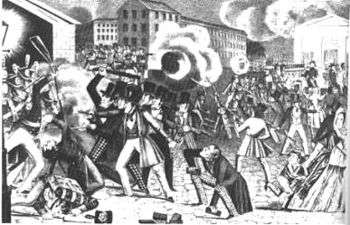
.svg.png)